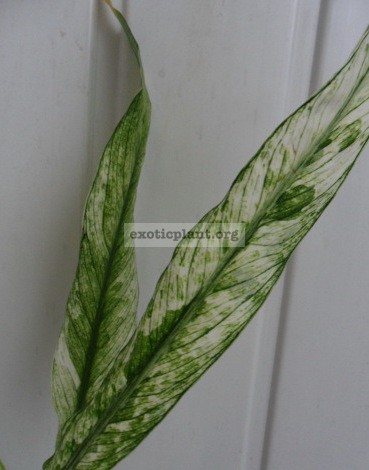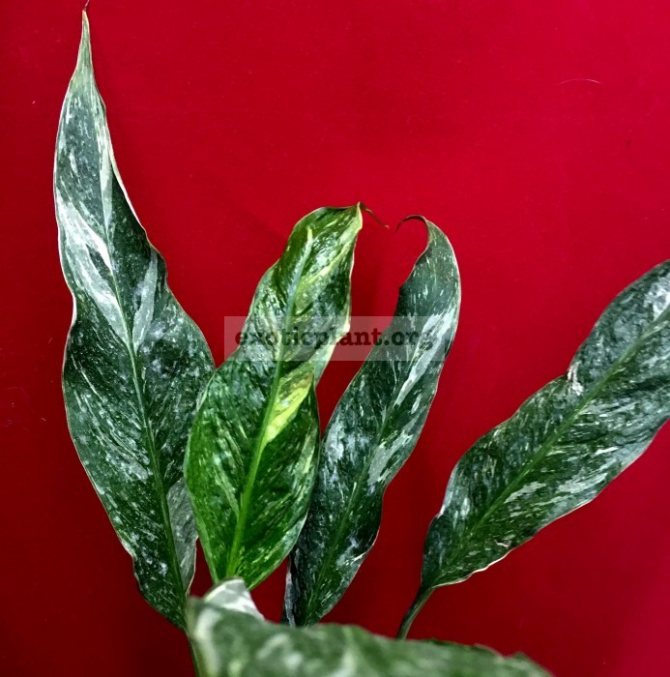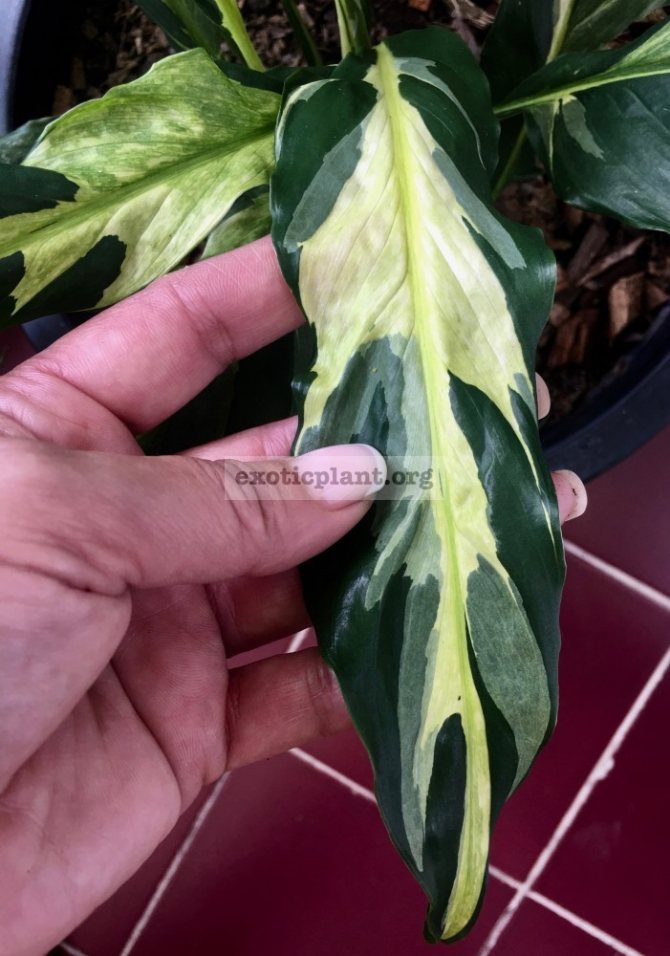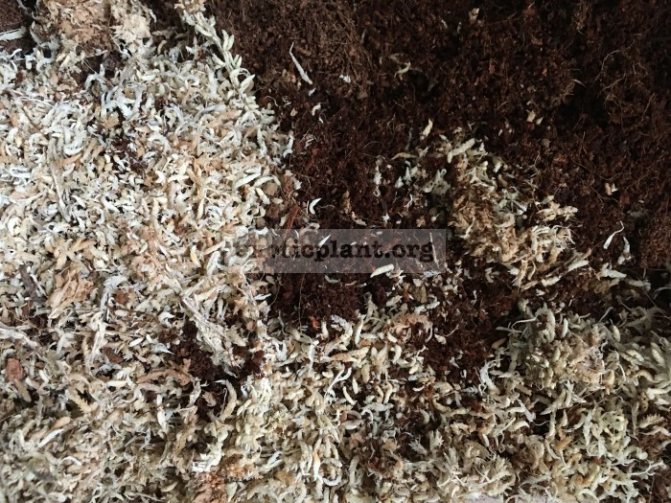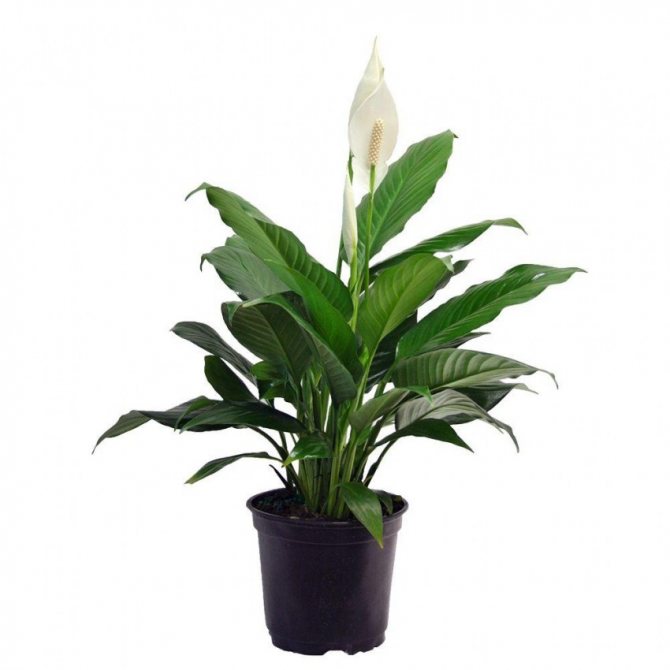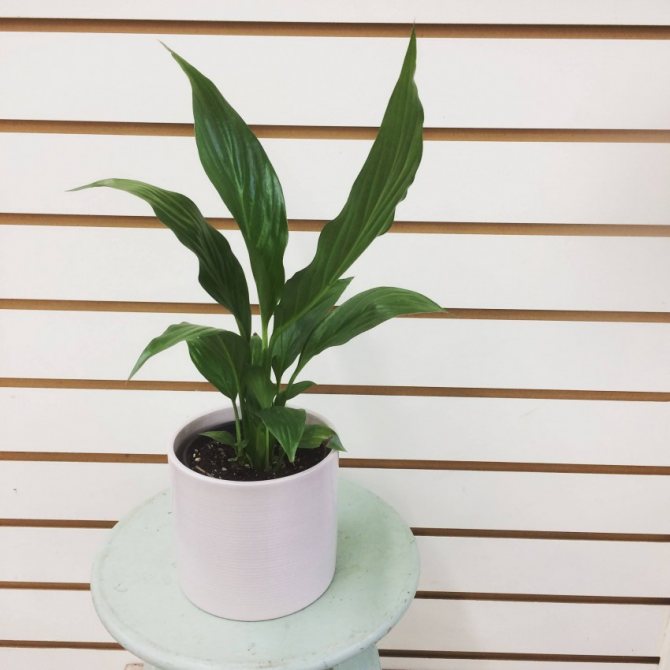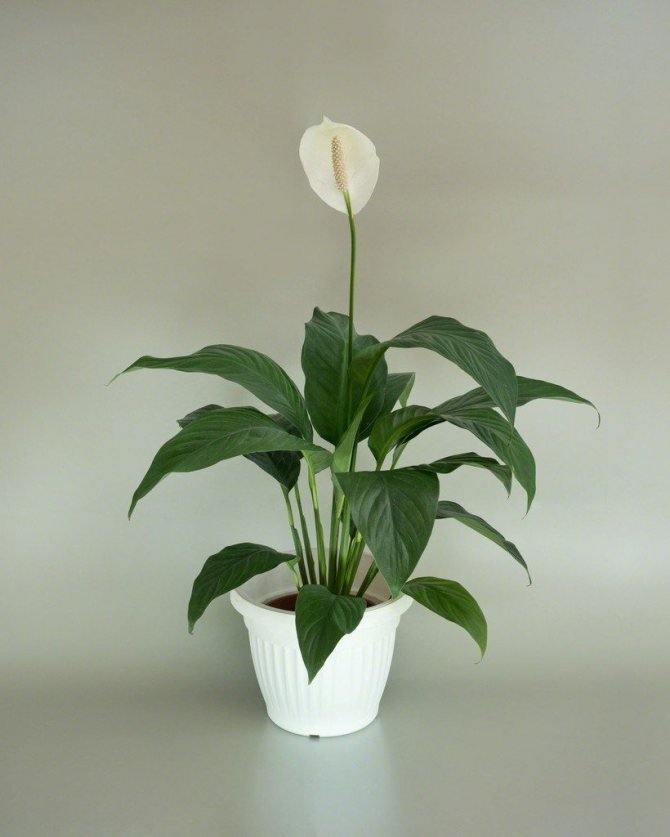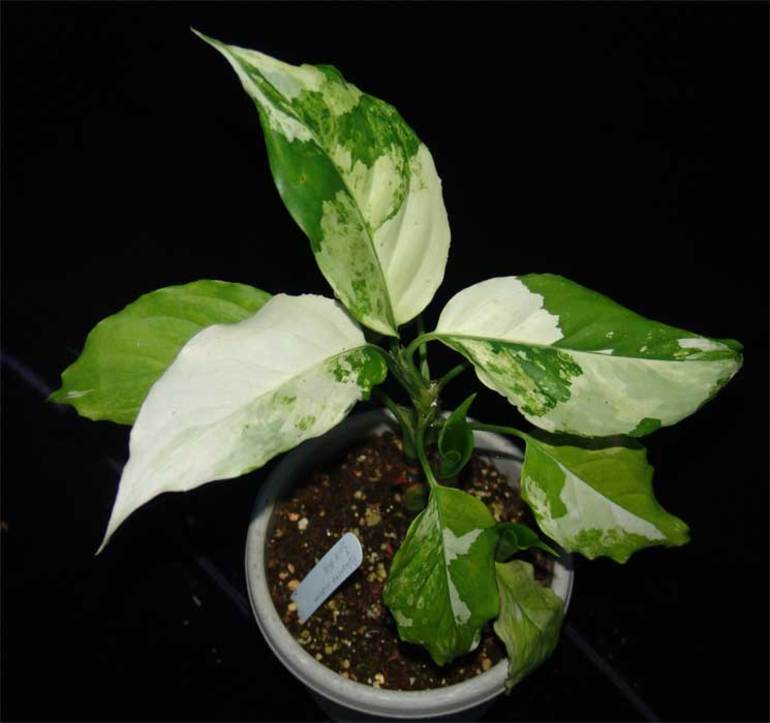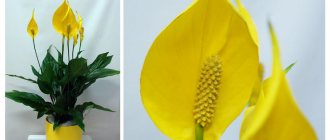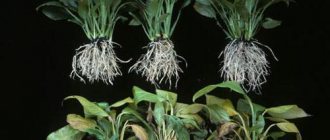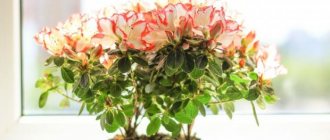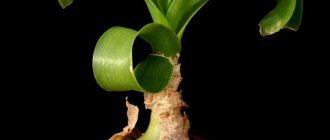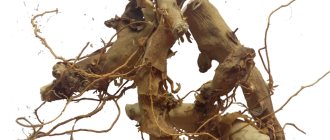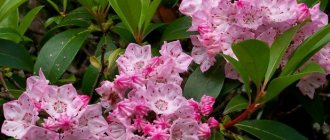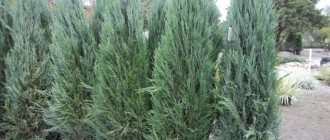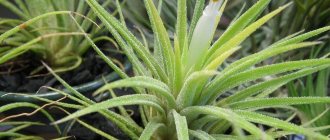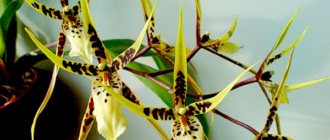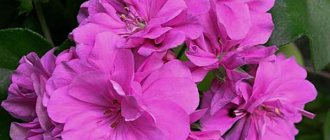Spathiphyllum is a frequent guest in the apartments of flower lovers. This exotic plant is native to South America and Southeast Asia.
Common in the humid tropics, where it rains regularly and is always warm. It is in this climate that it feels comfortable. In order for this flower to grow well, bloom and develop correctly in a city apartment, it is necessary to create similar living conditions for it.
In the heading you will see photos and names of species and varieties of indoor spathiphyllum (female happiness flower).
Spathiphyllum - species and varieties
Before considering in detail the varieties of spathiphyllum, let us dwell on the general description of this plant.
It is not for nothing that this flower is called “female happiness”, because if it has taken root well, develops and blooms actively, then we can say with confidence that there is love, mutual understanding and respect in the house. If there is no agreement in the family, the flower quickly fades, dries and dies.
The name of the plant comes from two Greek words: spathe and phyllon, which in translation mean "sword" and "leaf". This name is explained by the external similarity of the leaves and flowers of the plant with the sword.
The stem of the spathiphyllum is so shortened that it is practically absent, and the leaves and flowers grow directly from the ground. During flowering, peduncles with bracts rise above the plant, around which there is a yellow or white ear. What color does spathiphyllum have? There are various colors (yellow, orange, red), but most often, of course, there are white. These white bracts act as a kind of flag that should attract insects.
Modern botanists identify about 45 species of spathiphyllum. Among them there are both dwarf species and large representatives of this species. Most often, this plant is used as an indoor plant, sometimes for landscaping the territory, but only some of the species. It is impossible to find similar spathiphyllums among themselves. This flower is very dependent on the energy of the hostess, her condition and mood. Therefore, its size, color and flowering frequency will be different for each girl.
The presence of such a flower in the house also guarantees the presence of happiness in this house - light and large. The most popular type of this plant is profusely flowering. We will consider it first.
Flower legend, mystical properties
The people still live a legend that came from Ancient Greece. She is associated with the goddess of love Astara, who presented a poor girl from the crowd with a flower-heart on her wedding day. The goddess, happy and in love, endowed him with the ability to bring love, peace, tranquility, happiness into the house, that is, everything that she herself possessed at that moment. Since that time, the unusual flower began to be called "female happiness", believing that it is really endowed with magical properties.
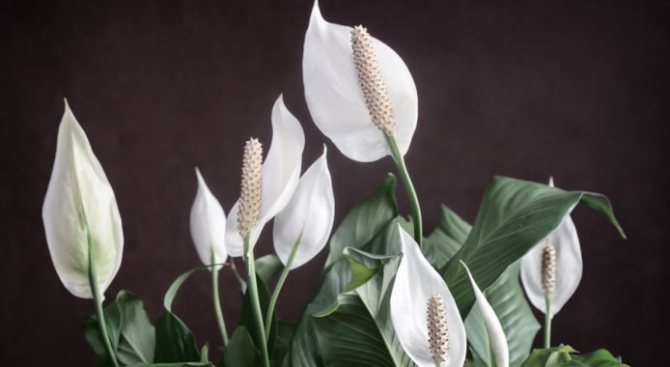
The magic of spathiphyllum:
- endows a lonely girl with "witchcraft" charms, promotes marriage;
- for the family it becomes a talisman, brings calmness, confidence, trust;
- helps to restore relationships, returns passion and harmony, which is important for conception;
- several simultaneously blossoming inflorescences - a sign of well-being for the family;
- the effect is enhanced when paired with anthurium (male happiness).
The donated flower has more power, accumulating in itself the positive energy of the donor.
Spathiphyllum profusely flowering
The types of spathiphyllum are very diverse.Abundant flowering is one of the most popular species of this plant. It is believed that his homeland is Colombia, or rather humid tropical forests, in which the sun practically does not reach the soil. Therefore, it is easy to identify the conditions in which it is recommended to keep this plant at home. Put it away from direct sunlight, provide partial shade and high humidity, both soil and air - and spathiphyllum will delight you with its flowering for more than one year.
But excess moisture can be dangerous, so you can't overdo it with watering.
The main feature of the profusely flowering spathiphyllum, in contrast to other plant species, is that it is able to bloom all year round. Actually, it was this difference that formed the basis of its name.
This type of flower is medium in size (about 50 cm high). The leaves are 20 cm long and 10 cm wide (no more than 12). As for the shape of the leaves, they are the same as in other plants of this genus: elongated, with a pointed tip, lanceolate. Their surface is a little rough, so veins are clearly visible on it. The creeping underground stem of spathiphyllum can produce almost 40 leaves at a time and is widely used in indoor plant growing for its decorative properties.
Is the plant poisonous or not?
Spathiphyllum Picasso juice contains calcium oxalates... In case of accidental contact with it in children and people prone to allergic reactions, the following symptoms may appear:
- hives on the skin;
- difficulty breathing;
- severe headaches;
- general weakness of the body;
- drowsiness;
- sweating.
Keep spathiphyllum out of the reach of children. If, nevertheless, it was not possible to avoid contact with the flower juice, it is necessary to show the child to a doctor.
Pets may have a different reaction. Oxalates are slightly soluble in water, settling in the renal pelvis, forming sand and provoking urolithiasis.
Cats eating leaves are threatened by swelling of the oral mucosa and burns to the esophagus and stomach. To help your pet on time, you need to pay attention to its general condition.
Juice poisoning may result in decreased activity, increased breathing and heart rate, and may also experience thirst, vomiting and diarrhea.
The animal must be given activated charcoal to drink., at the rate of 0.5 grams per kilogram of the cat's weight, and take the pet to the veterinarian.
Spathiphyllum is pleasant
All types of female happiness also include such a species as pleasant spathiphyllum. In terms of popularity, this species is not inferior to that described above. It is believed that this plant was first seen in the rainforests of America. It is there that the spathiphyllum can grow up to 1 m in length.
The leaves are dark green with an elongated lanceolate shape. A distinctive feature of this species is that the leaves on it are with a slightly bent tip. The flower stalks are strong and long, and on them there are white flowers similar to the flag.
Reproduction rules for spathiphyllum
The handsome man with "white sails" can reproduce by seed as well as vegetatively. Germination of seeds is a rather complicated process, moreover, seeds do not give very good germination.
A common method of transplanting a plant is dividing it into several bushes during the spring transplant. In order for each individual bush to take root better, it is first planted in a small pot, which is then changed during the subsequent transplant.
Popular: Growing beautiful inflorescences of exotic heliconia from seeds
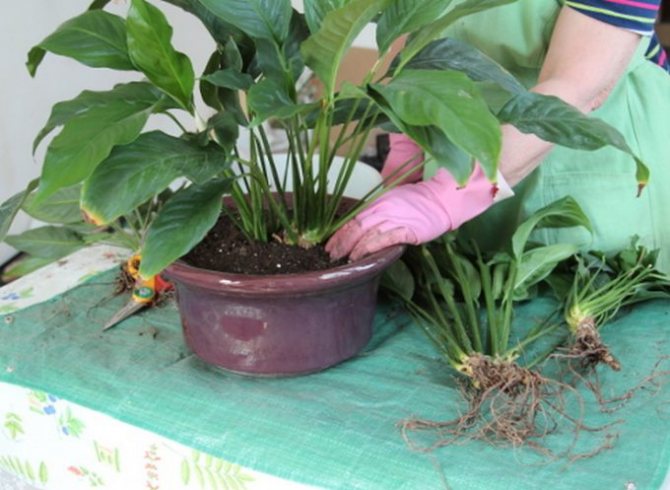

Spathiphyllum cannoli
Spathiphyllum cultivars include the canniferous species. You can meet such a plant in nature in countries such as Colombia, Venezuela, Guiana, as well as on the island of Trinidad. The name of this type of flower comes from the fact that its leaves are very similar to canna leaves - with a bright color, glossy surface, slightly elongated in the shape of an egg.
If you follow the rules for caring for the plant every day, then you will enjoy the abundant flowering every year, because cannoli spathiphyllum is completely unpretentious.It should be noted that the flowers of this species have a pleasant, unobtrusive aroma. The inflorescence itself is yellow-green, which is covered from above with a blanket of white-green.
Spathiphyllum blooms usually from April to June, but if you observe a fairly high humidity and a favorable temperature, then the flowers can appear again in late autumn or even at the beginning of winter.
Spathiphyllum leaves are located on long petioles and can reach a length of 50 cm. Thanks to such a dense vertical accumulation of leaves, the plant does not lose its popularity even when it is not blooming. Therefore, it is effectively used for decoration.
Cannolis spathiphyllum feels great in partial shade. Therefore, many experts believe that this type of plant is the best option for dark apartments. In order for the flower to grow well and regularly delight you with flowering, it is important to water the plant abundantly (but not overflow) and, if the air is dry, then spray it at least twice a day. Protect the flower from drafts and sudden temperature changes, and sometimes spoil the spathiphyllum with a warm shower.
Spathiphyllum growing / Spathiphyllum, review of varieties and content
Features of hybrid spathiphyllums and care for them
Spathiphyllum is one of the most popular plants for landscaping apartments, offices and winter gardens.
He came to Europe in the 19th century and still firmly holds the first positions in the list of the most unpretentious plants in room culture.
In numerous flower shops, a huge variety of hybrids are sold, from babies 15 cm tall to one and a half meter giants.
Dutch hybrids:
spathiphyllum Sensation - probably the most famous and most spectacular giant, the height of an adult plant is up to 1.5 m, the width is up to 2 m, the length of the leaf plate is up to 60 cm and the width is up to 30 cm.
spathiphyllum Sensation
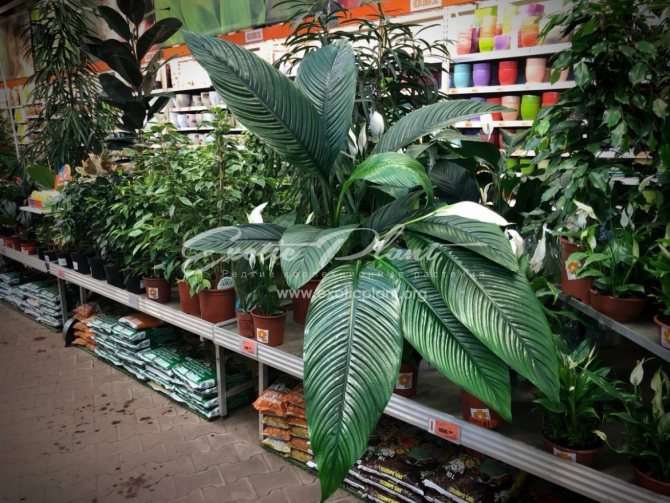

spathiphyllum Sensation spathiphyllum Sensation spathiphyllum Sensation spathiphyllum Sensation spathiphyllum Sensation spathiphyllum Sensation
spathiphyllum Sweet Lauretta - large spathiphyllum, up to 80 cm high and up to 1 m wide:
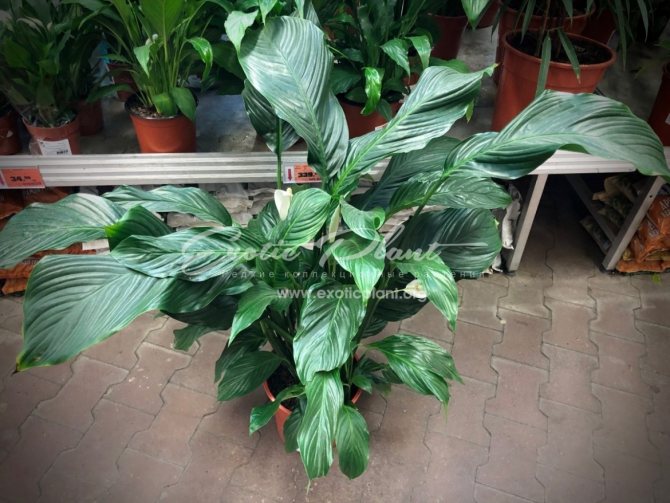

spathiphyllum Sweet Lauretta
spathiphyllum Sweet Lauretta spathiphyllum Sweet Lauretta
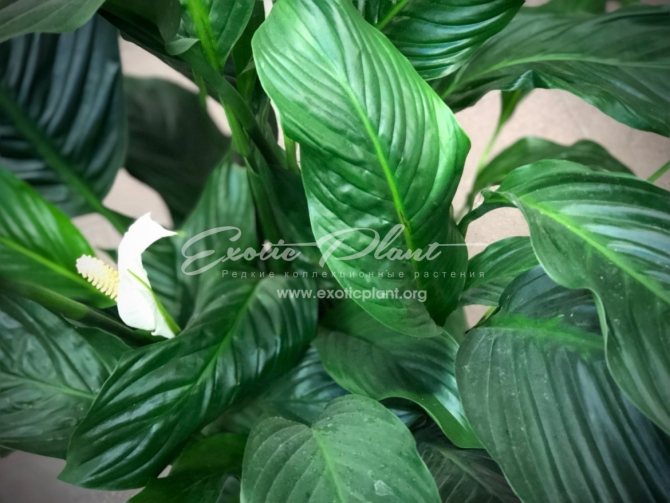

spathiphyllum Sweet Lauretta spathiphyllum Sweet Lauretta
spathiphyllum Сhopin (Spathiphyllum Chopin) - medium size, up to 50 cm in height and width
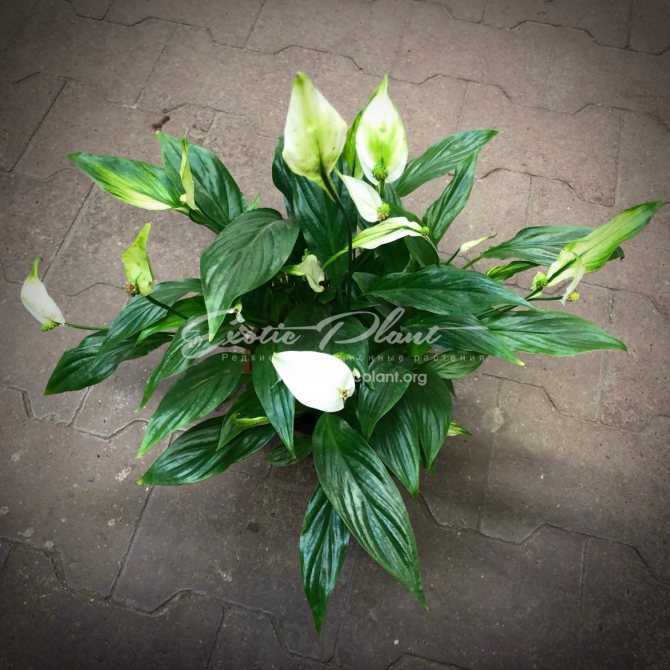

spathiphyllum Сhopin
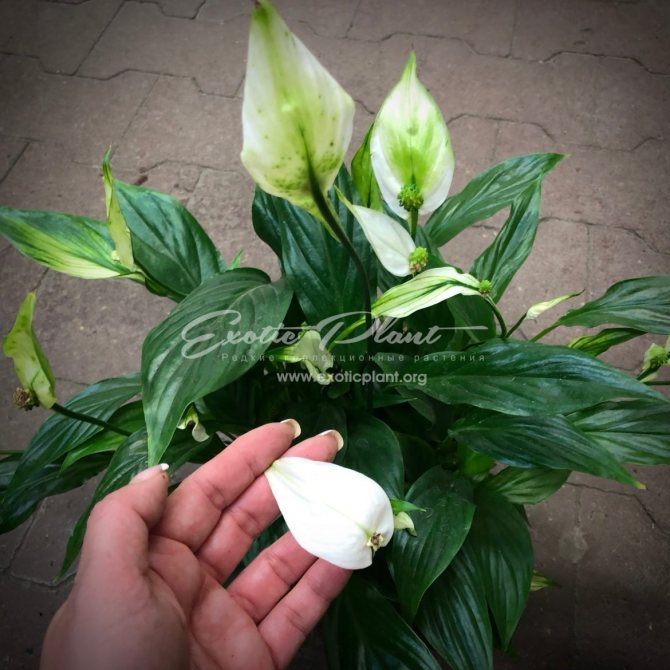

spathiphyllum Сhopin spathiphyllum Сhopin
spathiphyllum Tango (spathiphyllum Tango) - medium-sized, the height of an adult plant is 50 cm, the same width
spathiphyllum Tango
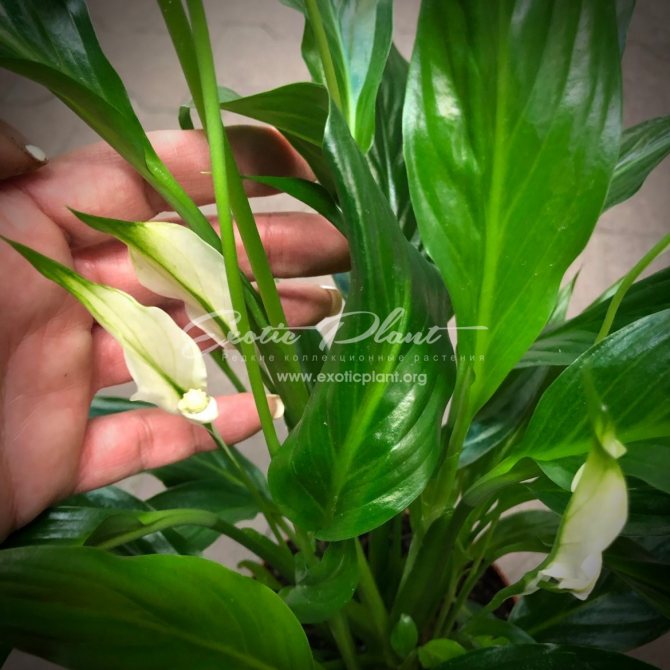

spathiphyllum Tango spathiphyllum Tango
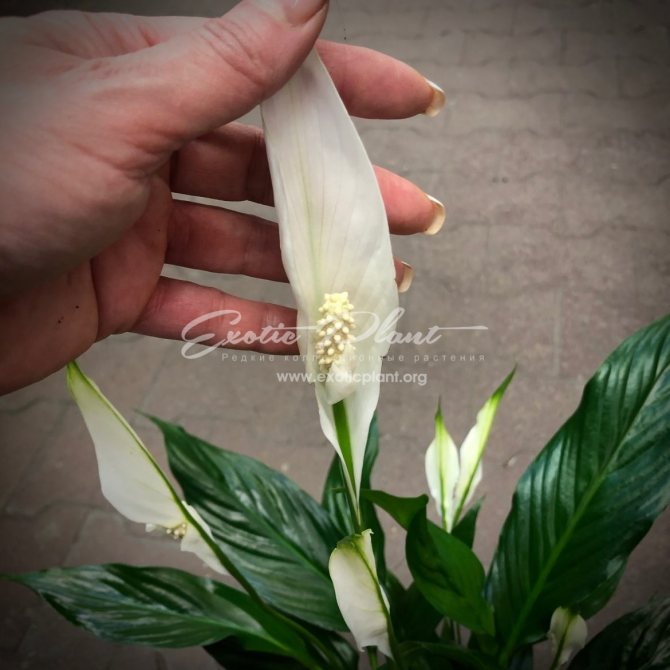

spathiphyllum Tango spathiphyllum Tango spathiphyllum Tango spathiphyllum Tango
spathiphyllum Verdi (Spathiphyllum "Verdi") - miniature spathiphyllum, about 30-35 cm in height and so much wide
spathiphyllum Verdi
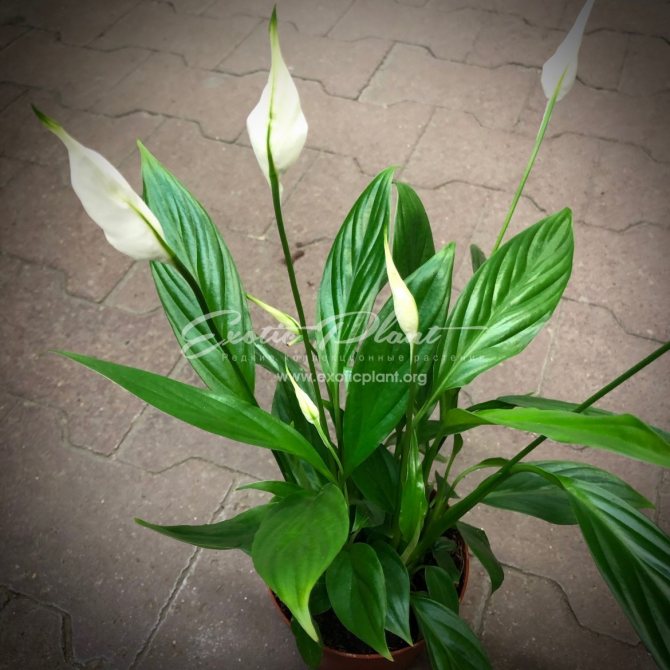

spathiphyllum Verdi spathiphyllum Verdi
Despite the fact that the genus Spathiphyllum includes about 40 species, native to the tropical regions of America and South Asia, American species almost did not participate in hybridization, and almost everything that you see on the market now is hybrids of Asian species. It is almost impossible to find species spathiphyllums now, and is it necessary, when there is such a variety of unpretentious and highly decorative hybrids on the market.
Among the species that took an active part in hybridization, I would like to mention the following:
Spathiphyllum cannifolium
- a fairly high spathiphyllum, up to 70-80 cm, with large ovoid leaves, spectacular and capricious appearance, requires high air humidity, does not like when the root system is disturbed. For the period of adaptation, its hybrids require greenhouse conditions, often shed the entire root system, but this is not a big problem if this moment is tracked in time. If, after receiving and planting, after a week when kept in a greenhouse, the leaves are still not turgid, it makes sense to remove the plant from the pot and examine the root system. If the root system is necrotic, it is necessary to completely remove all rotten roots. Do not be alarmed, even if you have to remove all the roots, there is nothing to worry about, the rhizome must be treated with a fungicide (Fundazol, Maxim), dried a little (a couple of hours is enough) and planted again in clean soil.As a rule, after a week or two, spathiphyllum begins to grow new roots and successfully adapts. Does not tolerate waterlogging, especially at the adaptation stage. However, if you find a common language with this spathiphyllum, you will be fully rewarded - cannoli spathiphyllum and its hybrids are distinguished by a velvety, sparkling in the sun, textured leaf surface that no one else has.
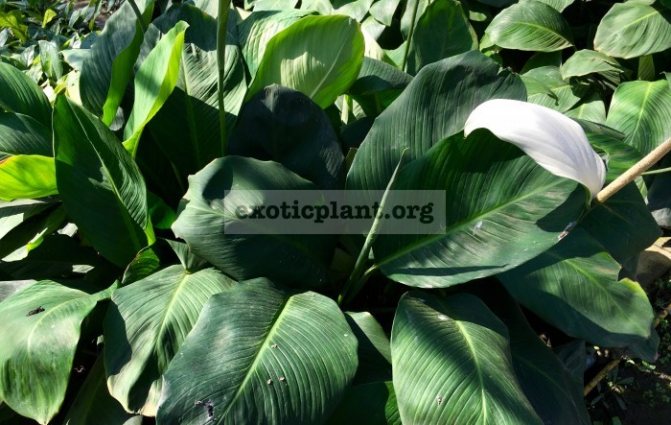

Spathiphyllum cannifolium
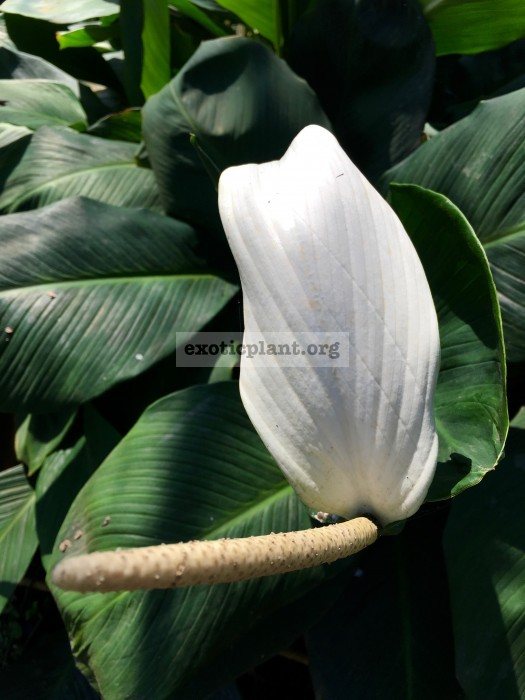

Spathiphyllum cannifolium
Spathiphyllum cannoli-based hybrids:
| Note: Hereinafter, when I write the specific name of cultivars before the name of the variety, it means that this species took part in hybridization, however, in fact, cultivars are not a variety of this species, they are hybrid, and it is correct to write Spathiphyllum hybr. cv Gold Satin (Spathiphyllum hybrid "Gold Satin", "Golden Atlas"), however, I would like to draw your attention to exactly which spathiphyllum exactly took part in hybridization. Unfortunately, it is not possible to trace the entire chain of participants in the creation of a particular variety. |
(Spathiphyllum cannolia "Gold Satin", "Golden Atlas") — very beautiful spathiphyllum, with lemon-chartreuse leaves, but like the species, it is very sensitive to the humidity of the air. If the air in the room is too dry, it will inevitably dry out the tips of the leaves, which will greatly ruin its appearance. The velvety surface of the leaf resembles a golden satin fabric; it also sparkles and plays in the sun. An adult bush is lower than the species cannoli and is rarely taller than 50 cm.
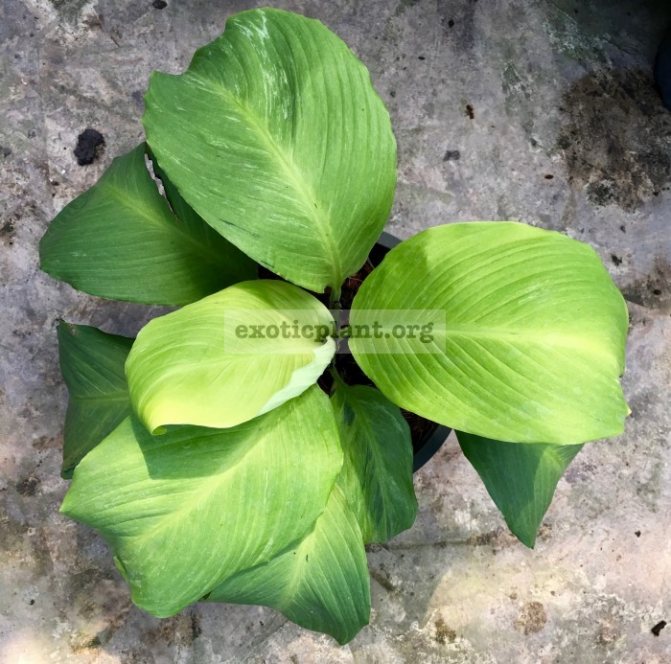

Spathiphyllum cannifolium Gold Satin 20-50
Usually the leaves have a relatively uniform yellow color:
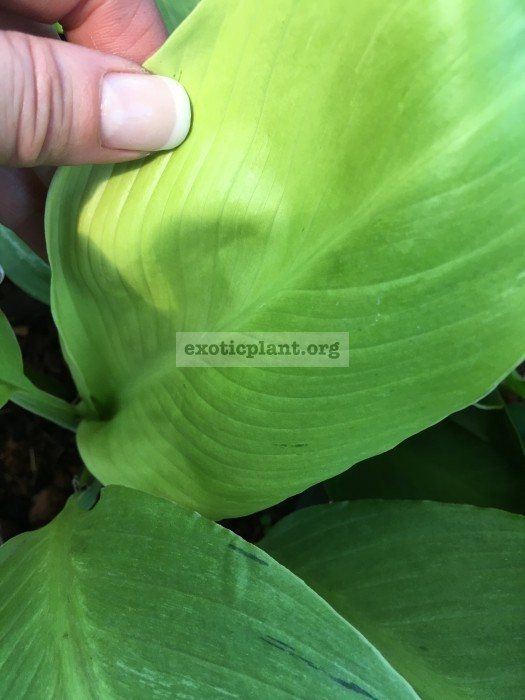

Spathiphyllum cannifolium Gold Satin 20-50
But in individual outlets, unstable variegation will occur (unstable means unstable transmitted, and even the next leaf in the same outlet will not necessarily be variegated):
Spathiphyllum cannifolium Gold Satin 20-50
Spathiphyllum cannifolium Gold Satin 20-50
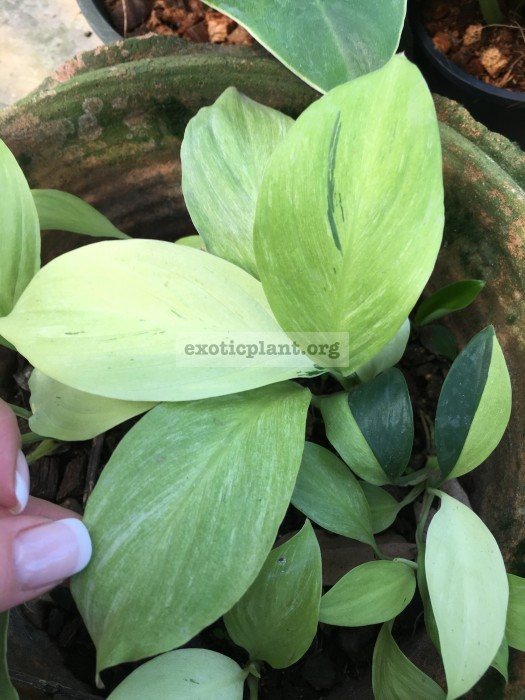

Spathiphyllum cannifolium Gold Satin 20-50
A rosette may appear in the bush, even with this type of variability:
Spathiphyllum cannifolium Gold Satin 20-50
But, again, this variability is not stable, and there is no guarantee that it will be stable even within the same outlet. It should be noted that this cultivar is very willing to give daughter outlets, releasing long underground stalons, so by buying one outlet of the normal yellow-leaved Spathiphyllum cannifolium Gold Satin (Spathiphyllum cannoli Gold Satin) you have every chance, when it grows, to get all the options within the bush colors shown above.
(Spathiphyllum cannoli with white variegation) - another noteworthy spathiphyllum. This variety is not as sensitive to air humidity as Spathiphyllum cannifolium Gold Satin. The height of an adult plant is up to 60 cm. Young leaves unfold with splash white variegation, the old lower leaves turn green, this is a kind of survival mechanism for this variety, the plant needs green cells capable of fully producing chlorophyll. A similar defense mechanism is observed in the host, the White Feather cultivar and the like. Stable variability, but some rosettes are prone to reversion - if young leaves of this cultivar grow green, consider yourself out of luck, this rosette is trying to recover to its normal green form, and it is likely that it will succeed.
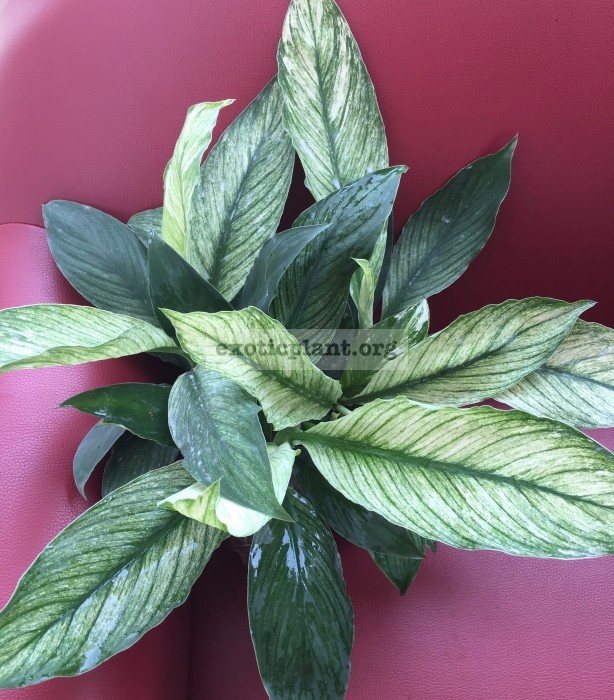

Spathiphyllum cannifolium (White variegated) 30
Spathiphyllum cannifolium (White variegated) 30
Spathiphyllum cannifolium (White variegated)
(Spathiphyllum cannolia "Silver Dust", "Silver Dust") - a rare cultivar, slightly larger than the two previous cultivars, the height of an adult bush is up to 70 cm, a characteristic feature is variegation in the form of white stripes randomly located along the entire surface of the leaf. Strong, unpretentious plant, quite tolerant to dry air.
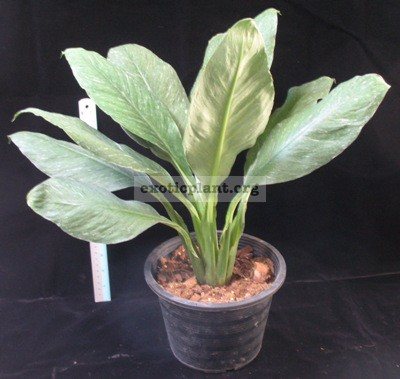

Spathiphyllum cannifolium 'Silver Dust' 30
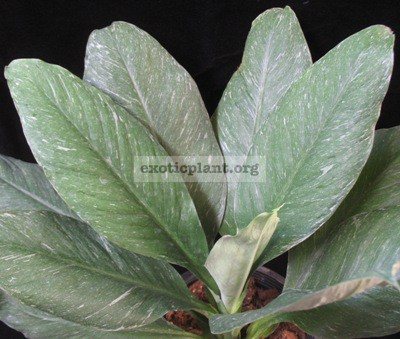

Spathiphyllum cannifolium 'Silver Dust' 30
Spathiphyllum blandum (spathiphyllum adorable) - the height of an adult bush is 60-70 cm, unpretentious, withstands low lighting, the species grows slowly, hybrids do not suffer from this disadvantage.
Spathiphyllum blandum
Spathiphyllum blandum
Spathiphyllum-based hybrids
adorable:
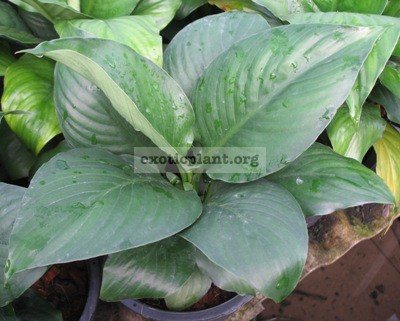

(Spathiphyllum adorable "Black Beauty", "Black Beauty") - earlier it was mistakenly listed in the catalog as a hybrid of cannoli. The cultivar, characterized by a very dark leaf color, glossy, dark green leaf blade, looks especially impressive against the background of yellow-leaved cultivars, which favorably set off its unusually dark greenery. The height of an adult bush is up to 60 cm, an unpretentious variety, holds the shade well, but for an intense color of the leaf, of course, it needs bright, diffused light, in a too shaded place it will give out etiolated shoots, the color of which will be normal for spathiphyllums, green.
Spathiphyllum blandum Black Beauty 25
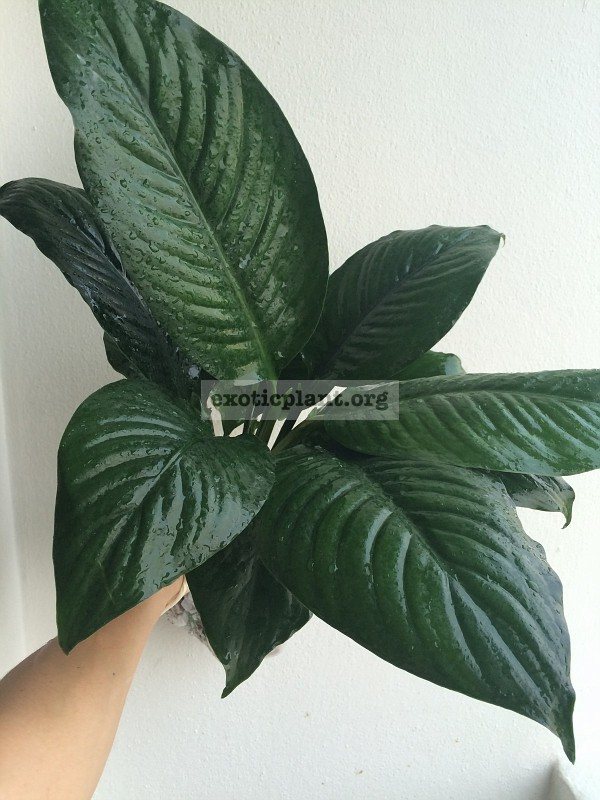

Spathiphyllum blandum Black Beauty 25
(Spathiphyllum adorable "Spilt Milk", "Spilled Milk") - was previously mistakenly listed in the catalog as a cannoli hybrid. A very spectacular and unpretentious spathiphyllum, perfectly holds the color even in low light conditions, young plants have an elongated and narrow leaf plate, in an adult specimen the leaf is rounded, with a pronounced thin tip, corrugated along the edge of the leaf, the color of the outer surface of the leaf is glossy grayish-bluish, as if milk had really been spilled on it, the underside of the leaf is light green. A strong, unpretentious variety, the height of an adult plant is up to 60 cm, it tolerates manipulations with the root system, easily tolerates the dry air of apartments, and grows quickly.
Spathiphyllum Spilt Milk
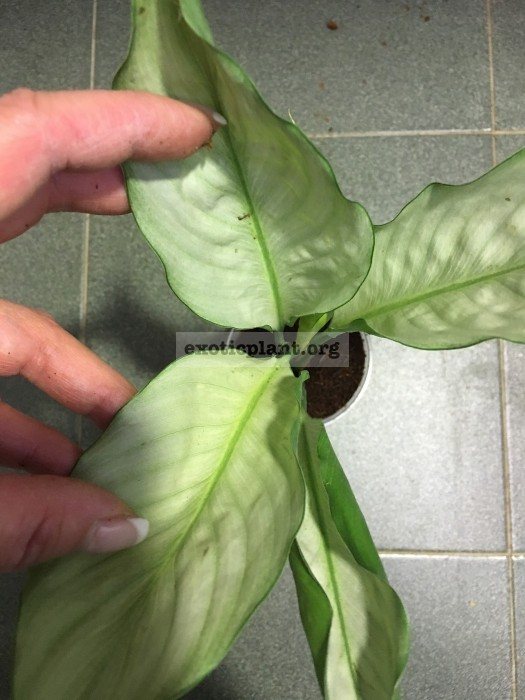

Spathiphyllum blandum 'Spilt Milk' 16-25-50
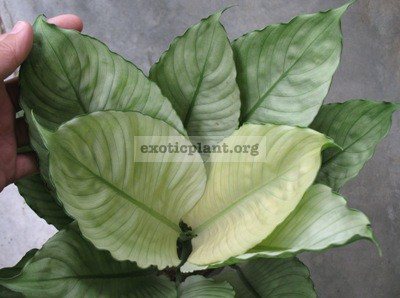

Spathiphyllum blandum 'Spilt Milk' 16-25-50
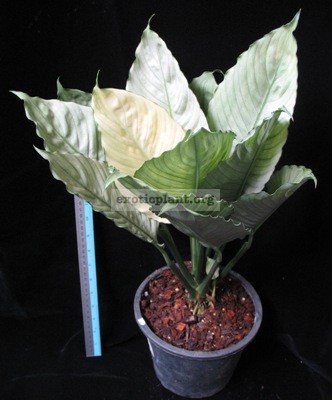

Spathiphyllum blandum 'Spilt Milk' 16-25-50
The variety keeps the color of leaf plates well when propagated by a tissue culture, and therefore, one of the most common varieties that reproduce by microcloning, and get plants that repeat the color of the leaf of the parent plant, but can give a fairly wide spread in other characteristics, including , shape and size of the sheet plate. As a result of reproduction by tissue culture, a mutation with a narrow, atypical leaf shape, which persists into adulthood, has appeared, Spathiphyllum blandum 'Spilt Milk' narrow leave clone (Spathiphyllum blandum "Spilt Milk" nerrow liv clone, Spathiphyllum blandum "Spilled milk", narrow-leaved clone ...
In an adult Spilt milk (spilled milk), young leaves unfold the color of baked milk, then, as they mature, the leaf becomes bluish-gray. In color, spilt milk and its mutation resulting from the multiplication of tissue culture Spilt milk nerrow liv are no different, just young plants do not demonstrate all varietal qualities, and it may seem to an uninitiated lover of spathiphyllums that there are several different variations of this spathiphyllum with different leaf colors the plates, however, are simply variations of the erratic coloration of a young plant. You don’t have to buy everything Spilt Milky offers you, you have to wait until they come into force and age to see the whole palette of colors.
Another, very interesting hybrid, spatithyllum hybrid South Thailand white splash = spathiphyllum Old Ghost / spathiphyllum "Old Gost", "Old Ghost"
Young leaves unfold with a pronounced milky-white splash variegation, the leaves turn green with age:
spathithyllum hybrid South Thailand white splash
A fairly large spathiphyllum, up to 80 cm in height, a spreading bush, is not capricious, but at the adaptation stage it can react to waterlogging of the soil by rotting the root system.
spathithyllum hybrid South Thailand white splash
spathithyllum hybrid South Thailand white splash
Spathiphyllum cochlearispathum (spoon-shaped spathiphyllum)
- the largest spathiphyllum up to 1-1.5 m high, with oblong-elliptical leaves. The length of the leaves is up to 40 cm, the width is up to 25 cm. The leaf blade is dark green, glossy, wavy at the edges. Originally from the tropical rainforests of Brazil, this species does not like dry air. Hybrids of this species are some of the most spectacular, but in order to get a truly grandiose specimen, you need to take care of humidifying the air in winter. For the adaptation period, a greenhouse is needed, the root, in contrast to the canniferous, does not drop very often, but if suddenly this happens, you do not need to be afraid, we remove all necrotic tissues, treat the rhizome with fungicide and plant, with the obligatory content in the greenhouse for a couple of weeks.The intensity of the variegated segments in variegated cultivars depends on the brightness of the illumination; with a lack of light, the variegation dims significantly.
Spathiphyllum cochlearispathum
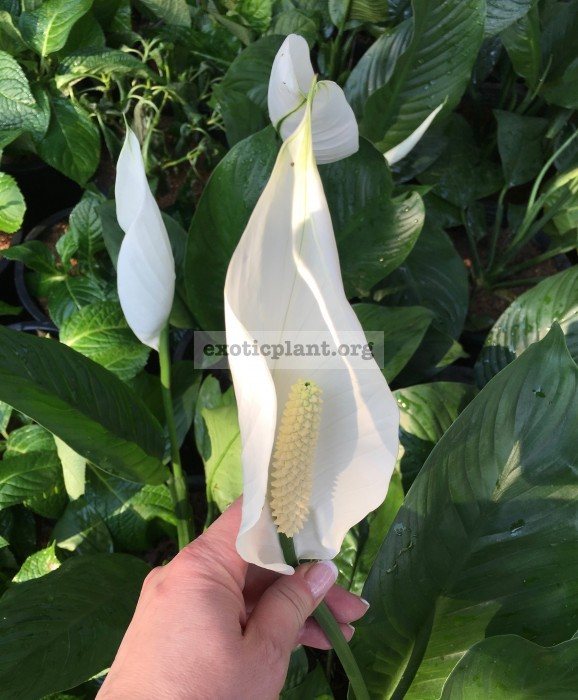

Spathiphyllum cochlearispathum
Hybrids based on spoon-shaped spathiphyllum:
Spathiphyllum cochlearispathum 'Sunny Sails' (white form) and Spathiphyllum cochlearispathum 'Sunny Sails' (yellow form) - comparison
(Spoon-shaped Spathiphyllum "Sunny Sails", "Solar Sails", yellow variegation) -was previously erroneously listed in the catalog as a cannose hybrid In potential, the largest of the cultivars presented in this article, height up to 120 cm, the same bush in diameter. Variegated form of the famous Dutch hybrid Sensation.
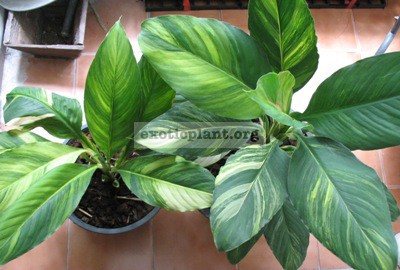

Spathiphyllum cochlearispathum 'Sunny Sails' (yellow form)
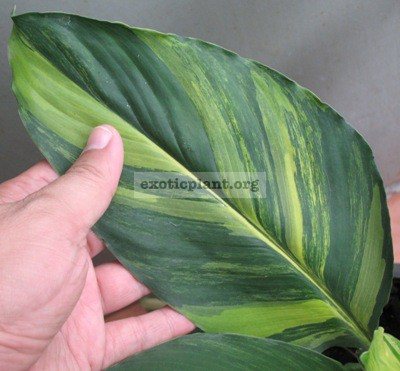

Spathiphyllum cochlearispathum 'Sunny Sails' (yellow form)
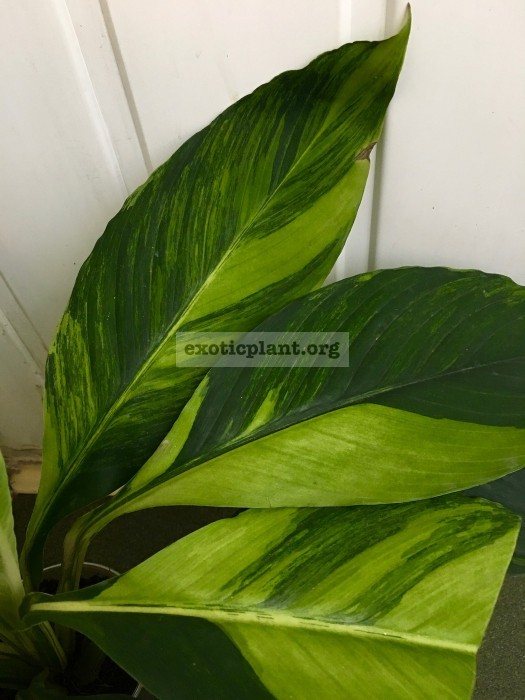

Spathiphyllum cochlearispathum 'Sunny Sails' (yellow form)
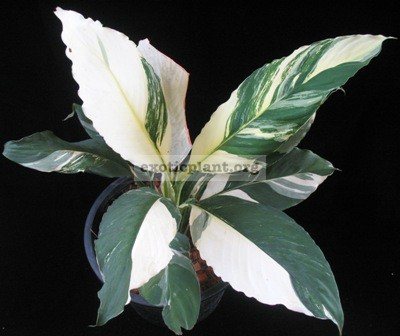

(Spoon-shaped Spathiphyllum "Sunny Sails", "Solar Sails", white variegation) - was previously mistakenly listed in the catalog as a cannoli hybrid. Another form, similar to the previous one, but with white variegation.
Spathiphyllum cochlearispathum 'Sunny Sails' (white form)
Spathiphyllum cochlearispathum 'Sunny Sails' (white form)
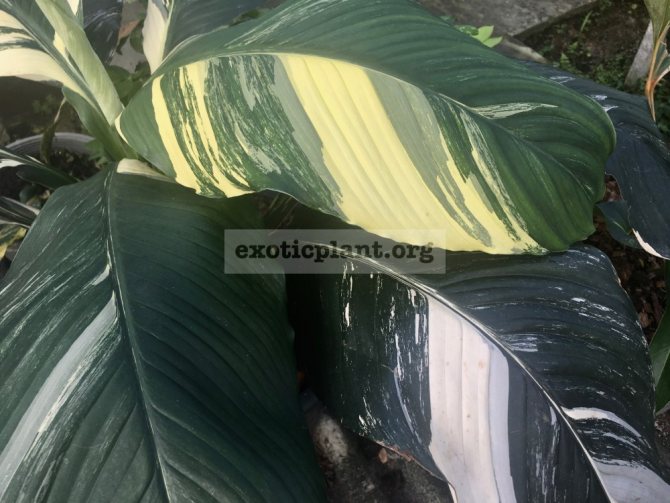

Spathiphyllum cochlearispathum 'Sunny Sails' (white form)
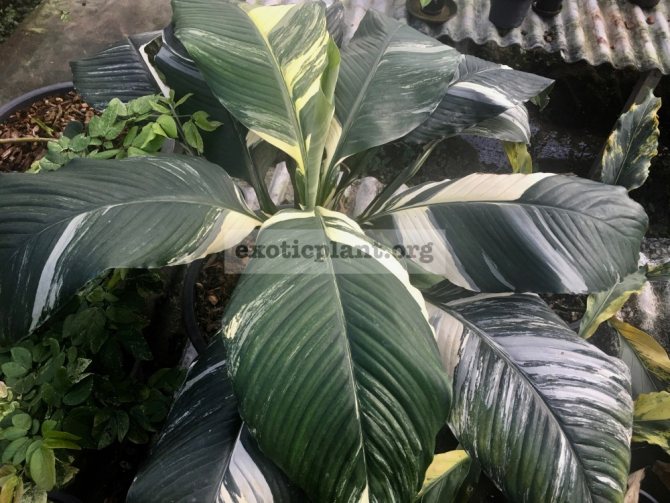

Spathiphyllum cochlearispathum 'Sunny Sails' (white form)
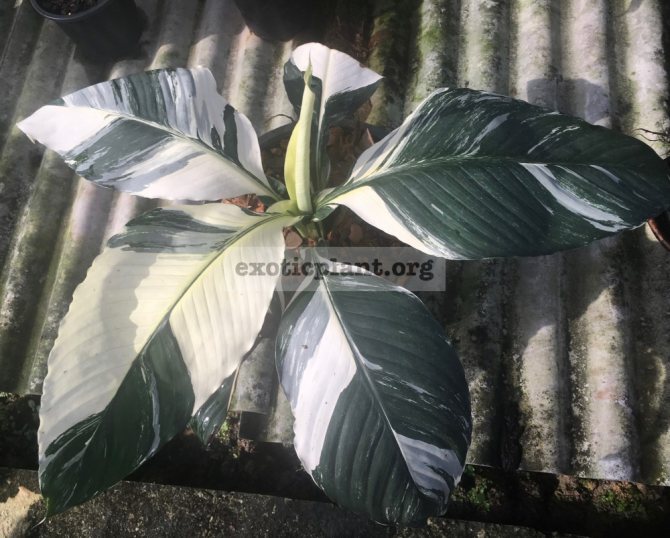

Spathiphyllum cochlearispathum 'Sunny Sails' (white form)
Spathiphyllum cochlearispathum 'Sunny Sails' (white form)
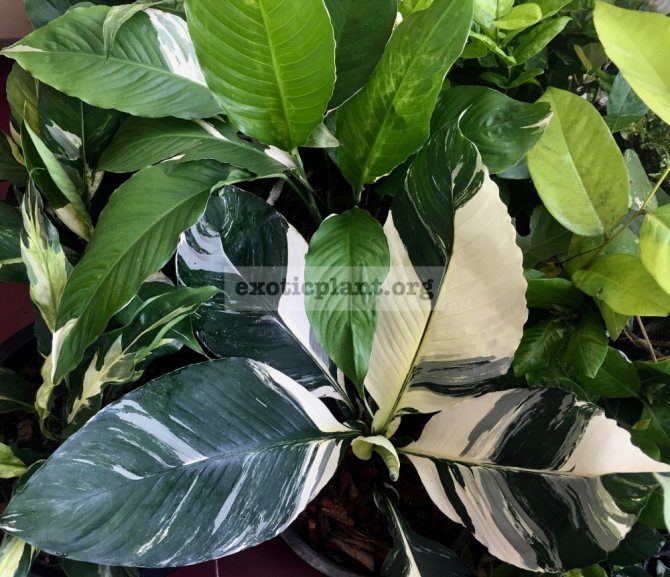

Spathiphyllum cochlearispathum 'Sunny Sails' (white form) and spathiphyllum sp ex Thailand white variegated
Spathiphyllum cochlearispathum 'Sunny Sails' (white form) and spathiphyllum sp ex Thailand white variegated
spathithyllum Sunny Sails (white form) = Sensation white variegated
spathithyllum Sunny Sails (white form) = Sensation white variegated
For comparison with the well-known Spathiphyllum cv "Picasso": spathithyllum Sunny Sails has a much more impressive adult size, its leaf plate is denser and wider. In the care spathithyllum Sunny Sails is much less capricious and much more tolerant of the dry air of our apartments.
Spathiphyllum cv "Picasso"
Spathiphyllum cv "Picasso"
Similar to Spathiphyllum cv "Picasso", but slightly larger - spathiphyllum sp ex Thailand white variegated:
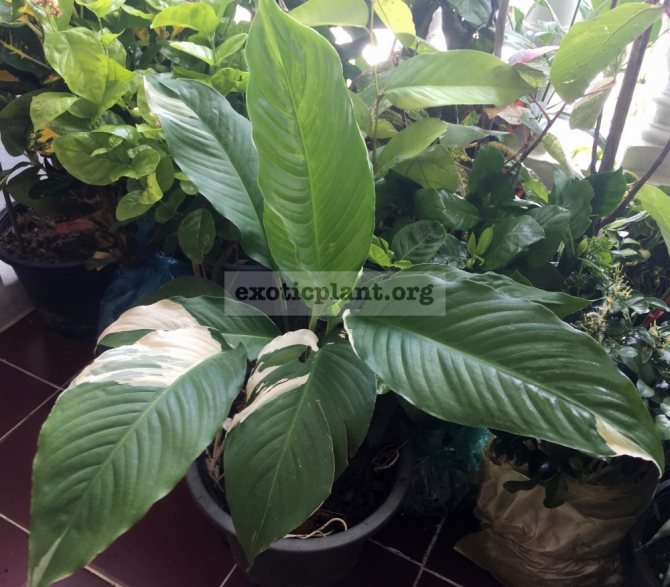

spathiphyllum sp ex Thailand white variegated
Spathiphyllum wallisii (Wallich's spathiphyllum)
- the most compact unpretentious of the presented species, hybrids based on it with a height of 15 to 40 cm, tolerant to the dry air of apartments, cultivars easily adapt after the stress of moving and are supportive of manipulating the root system:
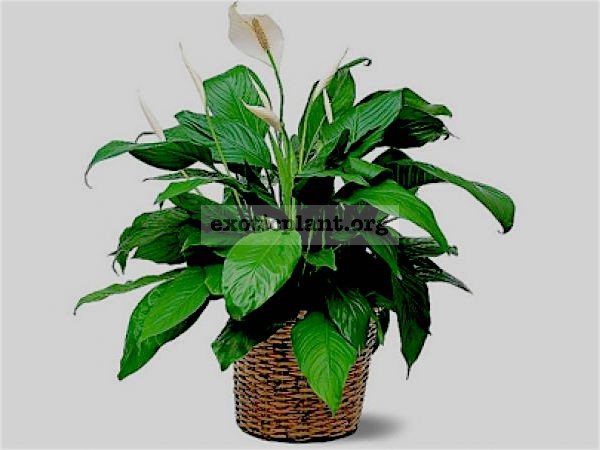

Spathiphyllum wallisii Photo from the Internet, author unknown
Wallich's spathiphyllum hybrids:
(Spathiphyllum "Angel Baby", "Angel Baby") - dwarf cultivar, the height of an adult bush is no higher than 25 cm, a narrow lanceolate leaf, splash variegation, stable, brighter in good lighting, white areas fade in the shade:
Spathiphyllum-‘Angel-Baby’
Spathiphyllum-‘Angel-Baby’
Spathiphyllum 'Angel Baby'
Spathiphyllum 'Angel Baby'
Spathiphyllum 'Angel Baby'
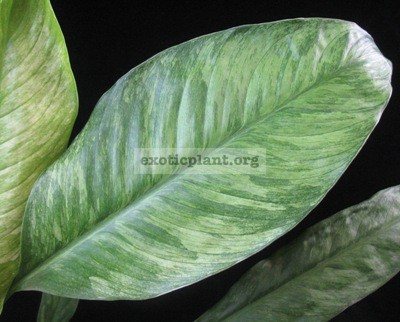

(Spathiphyllum "City of Angel", "City of Angel") - the elder brother of Spathiphyllum 'Angel Baby', juvenile rosettes are very similar to Spathiphyllum 'Angel Baby', but adult rosettes are much larger, up to 50 cm, the leaves of an adult plant become wider and change shape from lanceolate to oval-lanceolate. In one bush there will be both types of leaves at the same time:
Spathiphyllum 'City of Angel'
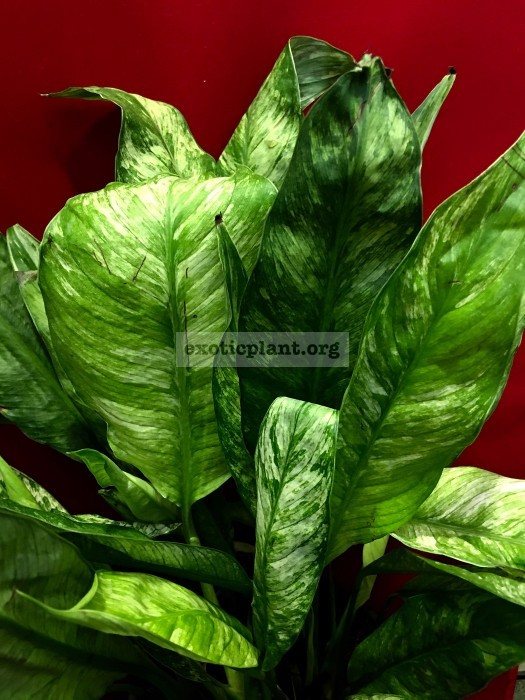

Spathiphyllum 'City of Angel'
Spathiphyllum 'City of Angel'
Spathiphyllum 'City of Angel'
Spathiphyllum 'City of Angel' 25
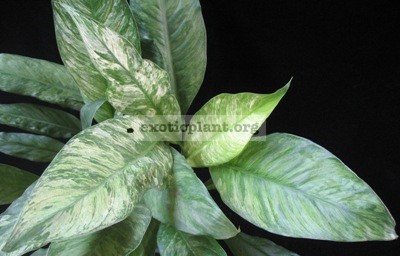

Spathiphyllum 'City of Angel' 25
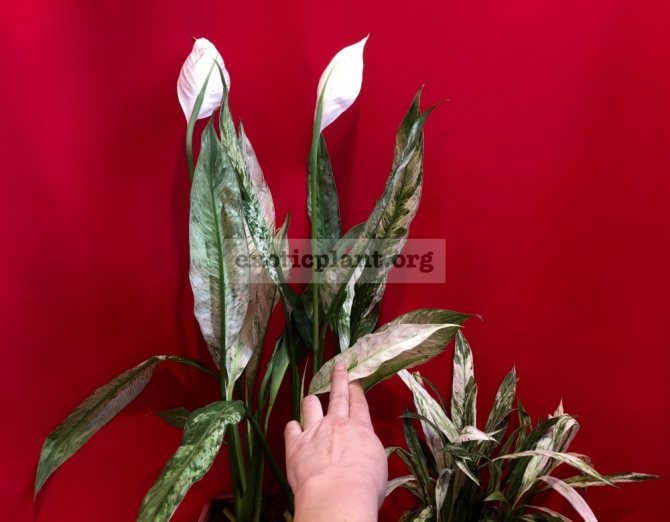

Spathiphyllum-‘City-of-Angel’-and-Spathiphyllum-‘Angel-Baby ’
Spathiphyllum-‘City-of-Angel’-and-Spathiphyllum-‘Angel-Baby ’
(Spathiphyllum Manua Loa, white variegated form) - variegated form of the well-known cultivar Manua Loa, one of the oldest hybrids of spathiphyllum. Absolutely unpretentious, firmly withstands all the difficulties of life, perfect for beginners. The height of an adult bush is up to 50 cm.
Spathiphyllum Manua Loa (White variegated) 30
Spathiphyllum Manua Loa (White variegated) 30
Spathiphyllum Manua Loa (White variegated) 30


(Spathiphyllum "Lemon Glow", "Shining Lemon") - the lemon color of glossy, shiny leaves leaves no one indifferent, compact spathiphyllum, the height of an adult plant is not higher than 40 cm. In the shade, the brightness loses and becomes chartreuse, in deep shade it turns green, but restores color saturation while maintaining a good level of illumination.
spathiphyllum Lemon Glow 30
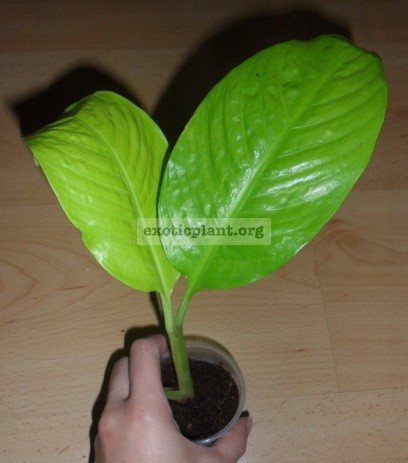

spathiphyllum Lemon Glow 30
(Spathiphyllum "Moon Shadow", "Shadow of the Moon") - similar to Spathiphyllum Manua Loa (White variegated), but yellow variegation:
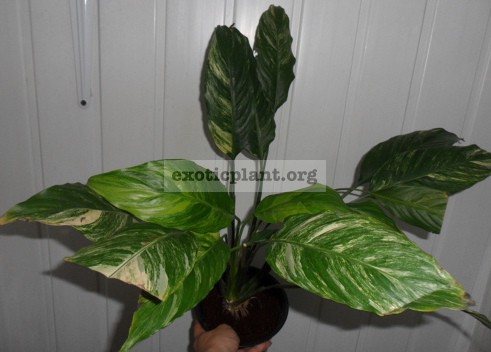

spathiphyllum Moon Shadow 30
spathiphyllum Moon Shadow 30
(Spathiphyllum "New Van", "New") - bright, with white segments, sometimes instead of it they offer Spathiphyllum 'City of Angel', however, these two cultivars are united only by the nature of growth and the shape of the leaf, they differ significantly from each other in the type of variegation, Spathiphyllum New One has pronounced white areas even in a young aged that do not lose brightness in low light.
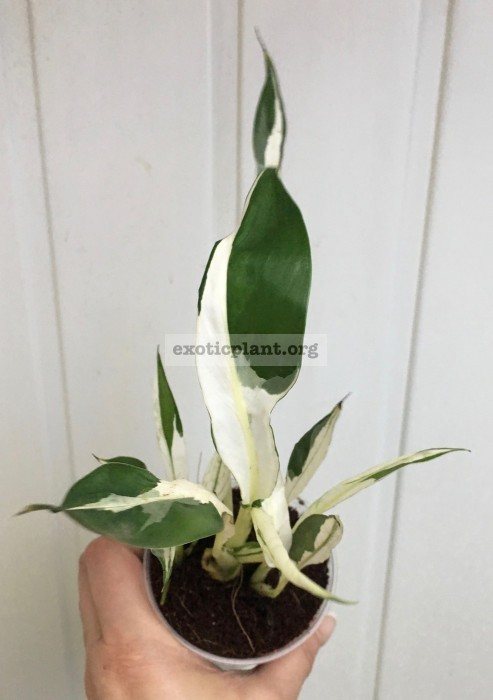

Spathiphyllum New One 20-30
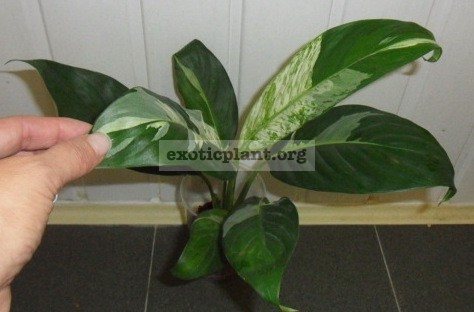

Spathiphyllum New One 20-30
Spathiphyllum New One 20-30
spathiphyllum sp ex Thailand white variegated and Spathiphyllum New One
(Spathiphyllum "Silver Rain", "Silver Rain") - very reminiscent of the well-known Domino, has the same "crinkled" leaf structure and growth pattern, but, in my opinion, there are still some differences - the leaf is slightly wider, and the variegation is brighter, the height of an adult bush is about 60 cm. Absolutely unpretentious variety suitable for beginners.
Spathiphyllum 'Silver Rain' 35
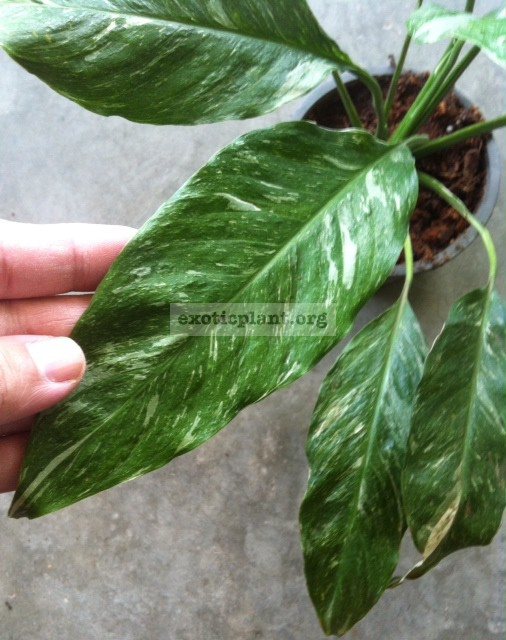

Spathiphyllum 'Silver Rain' 35
(Spathiphyllum "Silver Rain Dwarf", "Silver Rain", dwarf variety) - the compact form of the previous spathiphyllum, the height of the bush is usually 35 cm, the leaf is narrow, lanceolate, with an unusual torn edge and a relief surface of the leaf, along which splashes of white variegation are scattered.
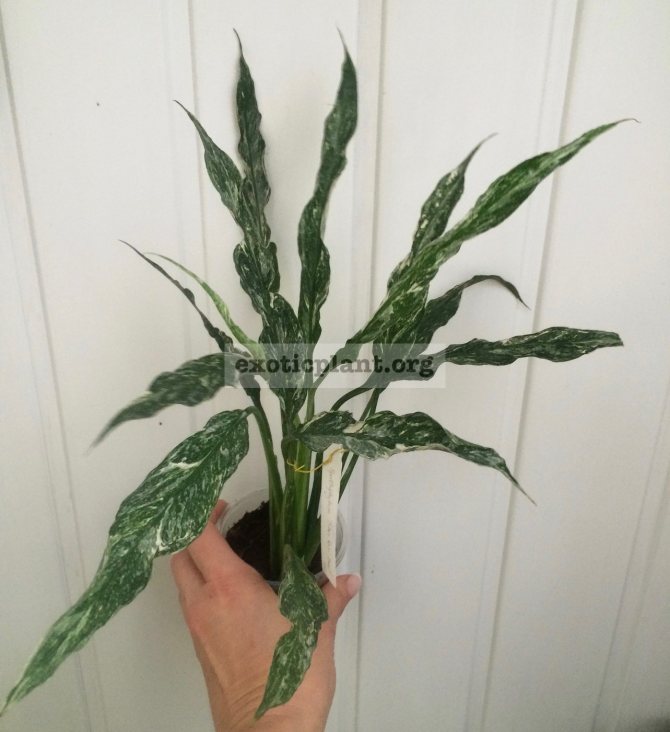

Spathiphyllum 'Silver Rain' dwarf
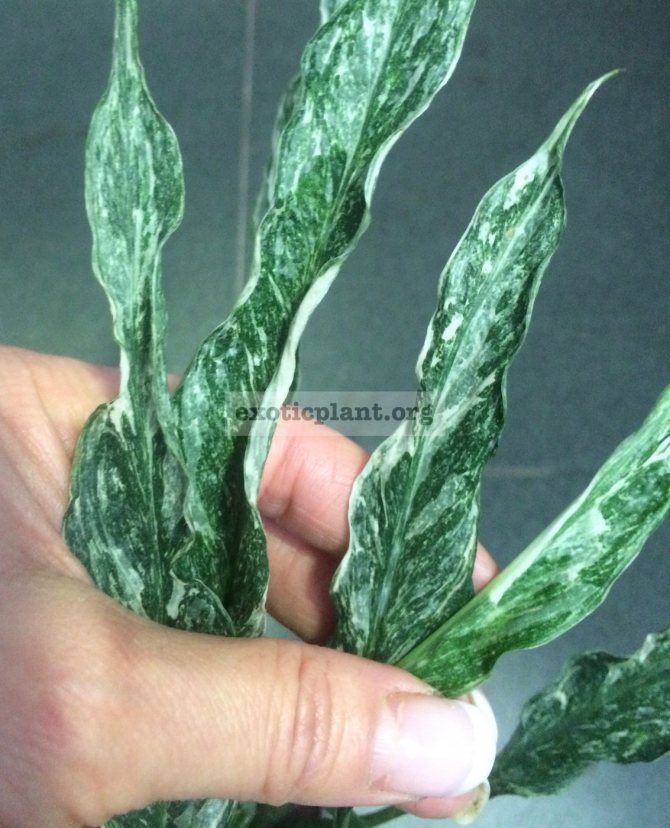

Spathiphyllum 'Silver Rain' dwarf 35
Spathiphyllum 'Silver Rain' dwarf
Spathiphyllum 'Silver Rain' dwarf
I often hear the question - and Spathiphyllum ‘Silver Rain’ dwarf - this is not the well-known Spathiphyllum “Domino”? No, these are different cultivars, look at the comparative photographs below - questions will disappear by themselves, the "Domino" has a crinkled leaf texture, but the leaf plate is wider, and the type of variegation is slightly different, it is very difficult to explain on the fingers, but if you put it side by side, the difference is obvious :
Spathiphyllum-Domino
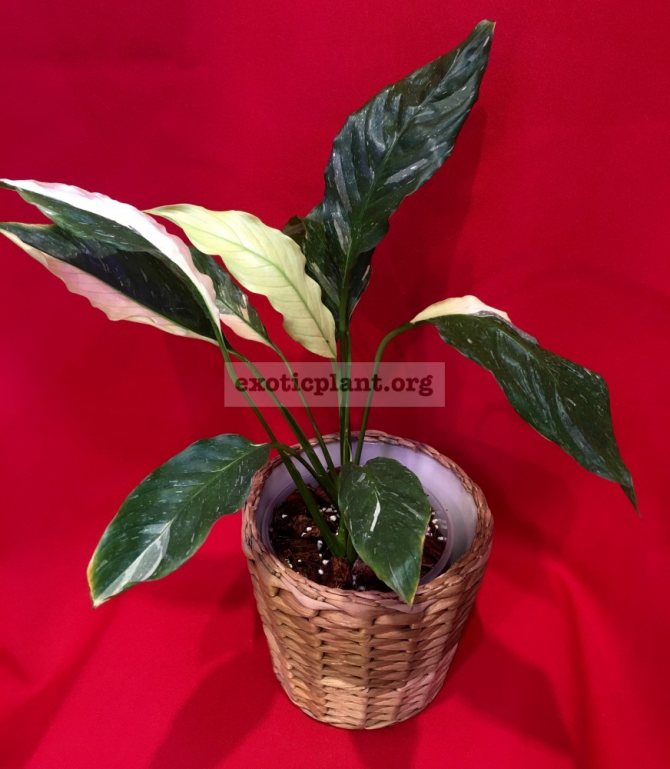

Spathiphyllum-Domino
Spathiphyllum-Domino-and-Spathiphyllum-‘Silver-Rain’-dwarf
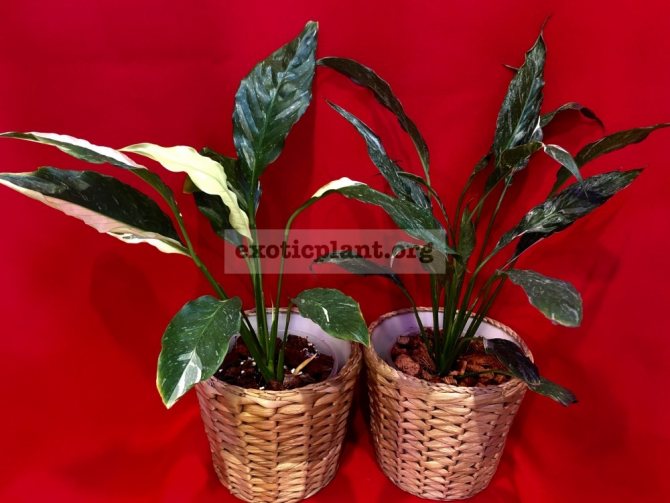

Spathiphyllum-Domino-and-Spathiphyllum-‘Silver-Rain’-dwarf
Another hybrid that has recently appeared on the market, which walks under different names, including the name "Delhi" (Deli, Delhi), but I have great doubts about the legitimacy of this name, so I prefer to call it - spatiphyllum hybrid ex Indonesiasince he came to us from Indonesia.
spatiphyllum hybrid ex Indonesia
This hybrid, in addition to a very bright, multi-colored leaf plate, which has a palette of overflows from dark green, glossy to grayish-green matte and from yellow to white,
spatiphyllum hybrid ex Indonesia
the cover of the flower is also two-colored, in addition, the flower has a pleasant, weak, but quite pronounced, sweetish smell:
spathiphyllum sp indonesia
Easy-care and fast-growing spathiphyllum.
Spathiphyllum floribundum (Spathiphyllum abundantly flowering)
medium-sized, 30 to 60 cm tall, spathiphyllum, very beautiful, with a dark green velvety leaf surface, a light central vein, but a very moody look, needs high air humidity. There are almost no real photographs of this species on the Internet, it is radically different from the vast majority of species spathiphyllums:
Spathiphyllum_floribundum - photo from the Internet, author unknown
Hybrid forms based on profuse spathiphyllum:
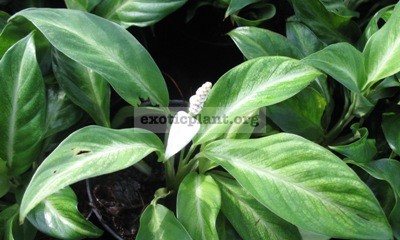

(Spathiphyllum abundantly flowering, miniature form) - the height of this spathiphyllum is only 10-15 cm, a charming baby, but, unfortunately, inherited the capriciousness of its parent:
Spathiphyllum floribundum Mini 9
Spathiphyllum floribundum Mini 9
Comparative table of varieties and cultivars:
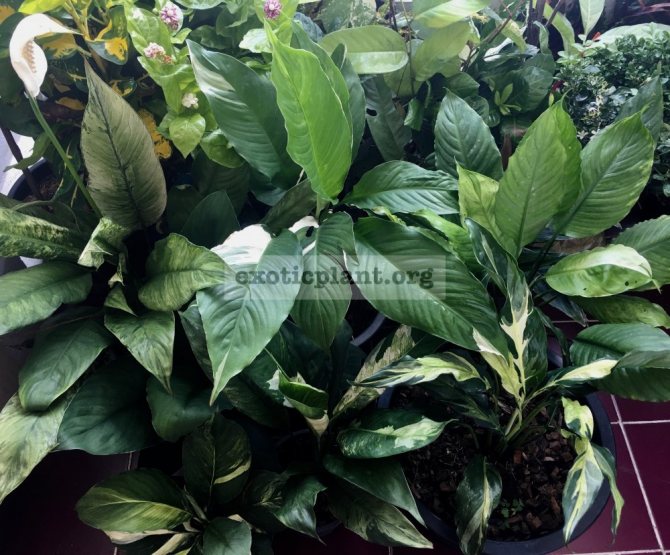

| Name | Photo | Height, cm | Features of growth and content |
| Angel baby |
| 25 | erect bush, narrow leaves, unpretentious, willingly gives daughter rosettes |
| Black Beauty | 60 | sprawling bush, oval leaves with a sharp tip, unpretentious | |
| Gold satin | 50 | spread out bush, wider than in height, capricious, sensitive to dry air, does not like dividing the bush | |
| Spilt Milk | 60 | erect bush, unpretentious, grows quickly | |
| Sunny Sails (yellow form) | 120 | sprawling bush, sensitive to dry air, the brightness of the segments depends on the level of illumination, does not like interference with the root system | |
| Sunny Sails (white form) | 120 | sprawling bush, sensitive to dry air, the brightness of the segments depends on the level of illumination, does not like interference with the root system | |
| Spathiphyllum cannifolium (White variegated) | 60 | sprawling bush, unpretentious | |
| Silver dust | 70 | upright bush, unpretentious | |
| floribundum Mini | 15 | sprawling bush, very moody, requires high humidity, but cannot stand the lack of air movement | |
| City of angel | 50 | erect bush, simultaneously on one bush lanceolate and oval leaves, unpretentious | |
| Manua Loa (White variegated) | 50 | upright bush, unpretentious | |
| Lemon glow | 40 | erect bush, unpretentious, the brightness of the color depends on the lighting, turns green in the shade | |
| Moon shadow | 50 | upright bush, unpretentious | |
| New one | 50 | upright bush, unpretentious | |
| Silver rain | 60 | erect bush, unpretentious, recommended for beginners | |
| Silver rain dwarf |
| 35 | erect bush, unpretentious, recommended for beginners |
| hybrid ex Indonesia |
| 60 | one of the most elegant spathiphyllums, flowers have a scent, unpretentious, found under the name "Delhi" (Deli, Delhi) |
| hybrid South Thailand white splash | 80 | sprawling bush, young leaves are milky white, turn green with age | |
| cv "Picasso" | 60 | capricious variety, requires high air humidity, tends to give out absolutely horophilous daughter sockets, which are able to live only as part of the mother bush and, when separated, die after a while | |
| sp ex Thailand white variegated | 80 | similar to cv "Picasso", but larger, the leaf plate is wider |
General recommendations for the agrotechnology of spathiphyllums:
Lighting
Spathiphyllums need bright diffused light, cannot stand direct sunlight, and if they quite favorably treat a certain amount of sun in the morning and evening hours in the autumn-winter season, then the spring and summer midday sun will leave ugly burns on the leaves, especially reverently for this include hybrids based on cannoli and profusely flowering spathiphyllums.
Temperature regime
Spathiphyllums need an even temperature regime in the region of 20-25 C throughout the year, they will tolerate a small daily temperature fluctuation, but it is not worth taking them out in the summer to fresh air, in our conditions, when in summer the difference between night and day temperatures can be very significant. spathiphyllums will react to this by dumping leaf mass and losing decorativeness.
Watering mode


Spathiphyllums love moderately moist soil, do not tolerate gulfs, some hybrids, such as (Spathiphyllum adorable "Spilt Milk", "Spilled Milk") they will react to overdrying the earthen coma with a loss of turgor, but quickly restore it without a noticeable loss of decorativeness, however, this should not be abused. Others like
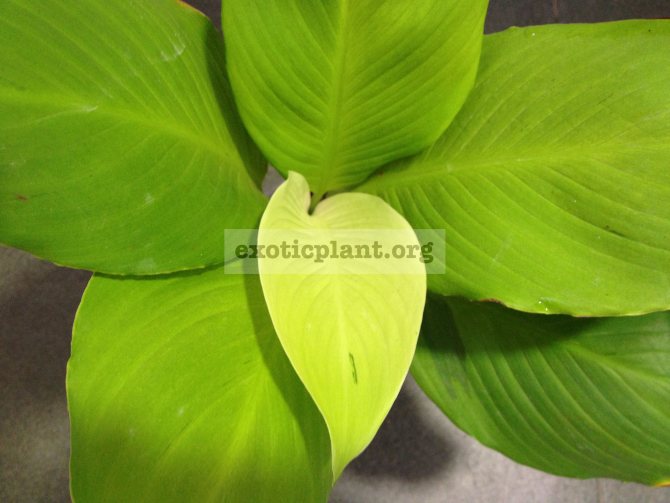

(Spathiphyllum cannolia "Gold Satin", "Golden Atlas") will react to dry earthen coma by dumping the leaf mass and a complete loss of decorative qualities. Watering should be regular, but moisture stagnation must be completely eliminated, the root system, for example, in (Spathiphyllum profusely flowering, miniature form) it will react to waterlogging with instant decay. General guidelines for watering your plants all year round can be found here.
Air humidity


Spathiphyllums prefer air humidity of at least 60 percent, some hybrids - at least 80 percent, the use of humidifiers during the heating season will help get rid of many problems not only with their own health (yes, the human body also does not like too dry air), but also with spathiphyllums. However, there are cultivars that tolerate dry air without much loss in decorativeness (see the table above), and if increasing the air humidity in the apartment is not included in your plans, it is better to pay attention to them.
Priming
|
Perhaps one of the most important questions that I would like to dwell on. I sometimes receive letters where they ask me what is wrong with my spathiphyllum, why does it regularly dry out the leaves, new leaves grow small and defective, what am I doing wrong? We begin to understand, and it turns out that on the advice of "experienced", spathiphyllum was planted in a completely unimaginable substance, consisting simultaneously of all the following components at once: perlite, horse compost, universal soil, sapropel, vermicompost, peat and bark. I'm not kidding, all these components were mixed in certain proportions, and in this substrate a long and happy life was expected from spathiphyllum. Despite the fact that spathiphyllums are quite unpretentious in terms of the substrate, they, of course, cannot withstand such mockery. Horse compost, sapropel and vermicompost at the same time is a hellish mixture that plants in the open field are still somehow able to digest, but in a pot culture, duplication of organic-rich and highly nutritious components is completely destructive for any plants, I don't even know if there is in the world a plant that is able to survive such an organic blow to the root system in container culture. Further, all industrial soils in the spirit of "universal" are composed using a large amount of peat, it is peat that is the main base of these soils. What guided the author of the recipe, adding peat to this "universal soil", again duplicating the already existing component, is completely incomprehensible. Perhaps, of the listed components, only perlite and bark, which are designed to be disintegrants, do not raise questions.I warn you against completely illiterate recipes, of which there are a lot on the Internet, compiled according to the principle "all the best at once", you are almost guaranteed to destroy the plant. So, the soil for spathiphyllums, as for all other plants in room culture, must correspond two main criteria: it must be air and moisture permeable. When watering, the earth clod should be well and evenly wetted, while the moisture should not stagnate.
I bring to your attention the components that can be used with full confidence in the safety and benefits for aroids, including for spathiphyllums, when planting aroids:
Coconut fiber: can be used both in pure form and as a component of the planting substrate:
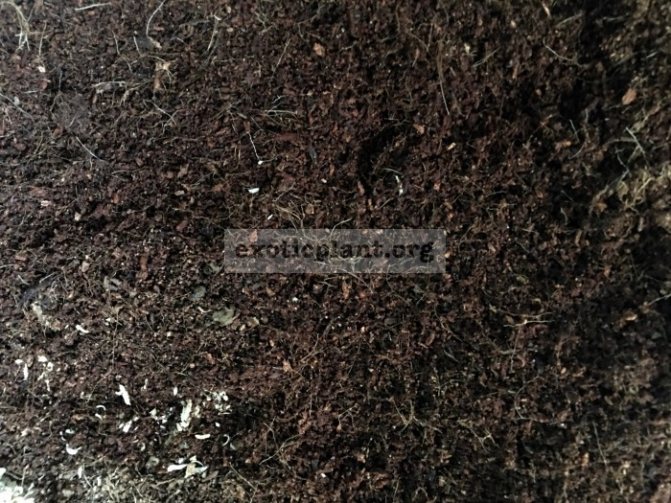

coconut fiber
Bark - Ideally, Orchiata, should not be used in its pure form, it accumulates too little moisture, the irrigation regime is difficult to adjust, but it is excellent as a component for a planting substrate for aroids, since it is present in the soil composition in regions of natural growth of aroids and spathiphyllums, including :
bark (Orchiata)
Coconut chips - an excellent option for growing aroids, including spathiphyllums, in their pure form. Can be used in soil with coconut fiber and moss:
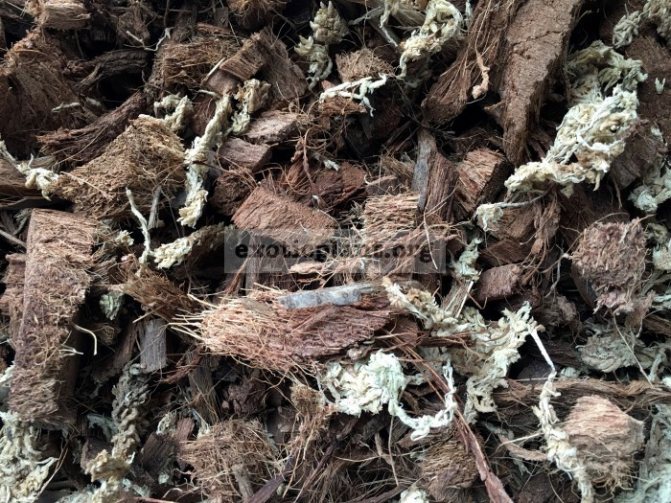

Cocochips
New Zealand sphagnum moss, you can take the cheapest, pressed, fiber length does not matter at all. It is used as an additional component for the preparation of a planting mixture for aroid and spathiphyllums, including, as well as a medium for rooting of aroid cuttings:


Sphagnum moss
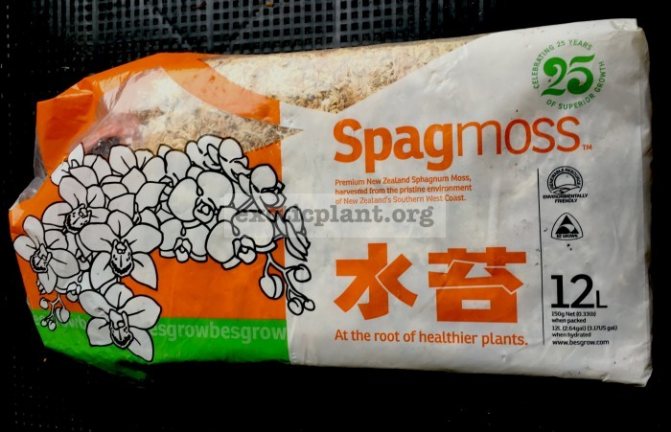

Sphagnum moss
I offered you compost components in which aroids, including spathiphyllums, will be guaranteed to feel good, but you can use other components, including those based on industrial soils, with the addition of expanded clay, perlite and other loosening components. It is only important to remember that the structure of the substrate should be sufficiently airy, and not monolithic, moisture-permeable, with good hygroscopic properties. I do not recommend using peat, unfortunately, over time, it forms a crust on the surface, which does not allow the soil to be wetted evenly. The danger of soils baking into a monolith is also in the fact that it is difficult for air to reach the roots, which negatively affects their function of feeding the plant, and also leads to decay of the root system. Well, you should not duplicate the components, there is no point in this if you are experimenting with the preparation of soil mixtures, do not waste time, effort and money on numerous and diverse components, as a rule, just a couple is enough - a base and a baking powder.
Top dressing
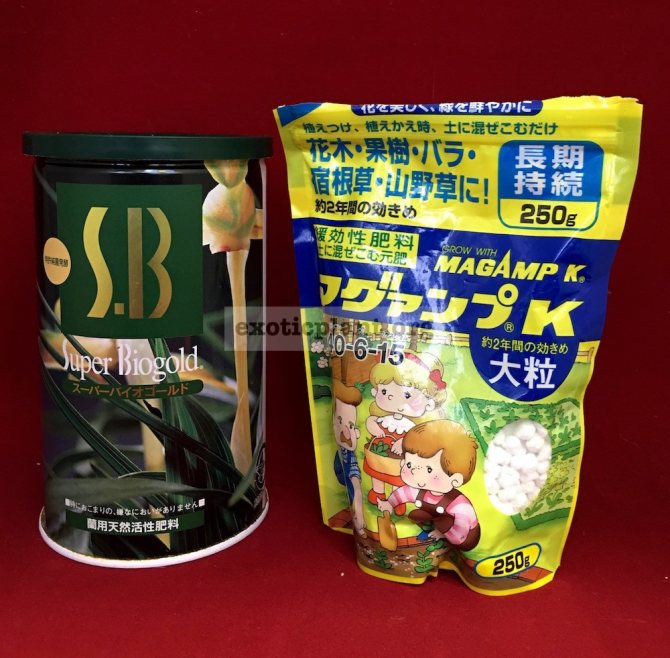

Ideally, when planting in the soil, it makes sense to add granular fertilizers, they are convenient, since they release nutrients slowly and dosed, depending on the ambient temperature and the degree of soil moisture, which means that during the period of active growth (spring-summer), when warmth and abundant watering, the granules will release much more nutrition into the environment than in the autumn-winter period, when the temperature is lower and watering is carried out much less frequently. If you have added the amount of granular fertilizer specified by the manufacturer, do not be afraid to overfeed the plant, granular fertilizers are produced using a technology that provides a slow and gradual release of nutrients.
How granular fertilizers work and why you shouldn't be afraid that they will release more nutrients into the soil than you need:
Granular fertilizer is based on the principle of placing nutrients under a layer of elastic polymer; nutrients are, as it were, encapsulated inside the shell. After irrigation, water penetrates through the pores of the polymer shell, and macro- and microelements dissolve in the water.Depending on the purpose of fertilizers (the manufacturer always indicates for how long specific fertilizers are designed for), granular fertilizers are 3, 6, 9 or 12 months of action, which means that with adequate watering, the granules will give up all their nutrients gradually during the specified period ...
The elastic membrane of the capsule retains its properties during the entire working period: the shell is not damaged by mechanical action on the soil. The shell consists of an elastic polymer that slowly degrades in the soil and guarantees the availability of substances depending on the needs of the plants.
If you do not want to use granular fertilizers applied when planting in the ground, you can use liquid fertilizers for ornamental plants, adding them to watering according to the manufacturer's recommendations.
Regardless of what form of mineral fertilizers you use, in the spring-summer season it makes sense to periodically add organic fertilizers that are convenient for you - based on vermicompost, sapropel, mullein. Be careful when using biofertilizers based on horse and chicken manure, they are very active and can harm the plants. If you are unsure, it is better to make the solution less concentrated than indicated on the package, and most importantly, never exceed the dosage indicated by the manufacturer.
When applying organic and mineral liquid fertilizers, one rule must be taken into account - never water the plants with a solution of organic or mineral fertilizers on dry soil. Before applying organic or mineral liquid fertilizer, the soil must be shed abundantly with just water.
Use dry organic fertilizers in the soil for any plants in room culture I strongly do not recommend, they can be unevenly distributed throughout the pot, the concentration can be exceeded, in addition, organic matter in the pot is a breeding ground for saprophytes, to which pathogenic fungi and bacteria can join.
Announcement: An article on the features of soil compilation for different groups of plants is under development, because, I believe, this question is of interest to many - what can you save on, what you can't do without, how to optimize soil costs, what are the typical mistakes of beginners - I'll tell you about everything, come back often and follow the site's news!
Spathiphyllum catalog:
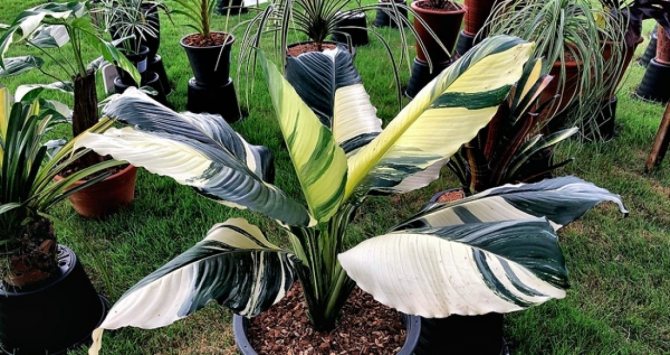

Spathiphyllum / Spathiphyllum, catalog
Spathiphyllum spoon-shaped
Tropical countries such as Brazil and the equatorial rainforests are considered the birthplace of the spoon-shaped spathiphyllum. Previously, it was believed that in such tropical countries grow two separate types of "female happiness". Heliconiophyllous spathiphyllum has long been considered a separate species, until it became clear that it is one and the same flower. Therefore, now this name is used as a synonym for spoon-shaped spathiphyllum.
The height of this species can reach up to 1 m, and large leaves can be up to 40 cm long. At the same time, they are attached to petioles, which in turn reach a length of 70 cm. Impressive size for a house plant, isn't it?
This type of spathiphyllum is very unpretentious, like its relatives. Provide the flower with protection from direct sunlight, high humidity and regular watering. These conditions will be enough to see it bloom in the spring. The key difference between this type of spathiphyllum from others is how the flower is developed. At first, the inflorescence is yellow, and gradually darkens until it turns black. The cover over the inflorescence is usually white and, as a rule, does not change color. It is very long and wide (at least twice the size of the inflorescence), shaped like a sail filled with wind.
Bloom
It begins with an increase in daylight hours - the first flowers appear in May, abundant flowering continues throughout the summer, and ends almost at the end of September.The flowers are small, light yellow in color, collected in an inflorescence of a cob, covered with a white round perianth. After the end of flowering, the perianth does not dry out, but changes color and turns green. Seeds ripen on the cob that can be harvested and planted to produce a new robust plant adapted to the conditions.
Wallis Spathiphyllum
Wallis spathiphyllum is also one of the most popular types of "female happiness". Its main difference is its small size. It is because of this that botanists ranked this species as a dwarf plant. Under conditions of home care, this plant can reach a length of up to 40 cm. The rhizome is short, and on it are small neat oblong leaves of a lanceolate shape and dark green color.
The ear of this species is white, and the veil is narrow, but long (at least 3 times longer than the inflorescence). This type of "female happiness" blooms profusely and for a long time. Wallis's spathiphyllum can very often be found on the windowsills of modern housewives due to its unpretentiousness, compactness and beautiful appearance. It has excellent decorative properties.
Accommodation in an apartment
Since the strong sun is harmful to the plant, it can be placed on the windowsill only in those rooms whose windows face north.
However, many people grow the flower in bright sunny living rooms, because it is a rather large and very decorative plant that decorates a room. In this case the flower should be placed not on the windowsill, but on a separate bedside table or table farther from the windowso that diffused light falls on it. This will protect it from the direct sun, and will look beautiful in the interior of the living room.
Now you have seen the varieties of spathiphyllum and you can choose the one that suits you.
Spathiphyllum Mauna loa
Colombia is the country that is considered the birthplace of the spathiphyllum Mauna Loa. It was from this country that Wallis's spathiphyllum was once brought. Mauna Loa is a plant that has a wide white elliptical bracts that gracefully cover a cream-colored ear. The leaves are pointed, bright green, and the petioles, which grow from a short (and sometimes underground stem), are up to 10 cm long. The cobs of this type of "female happiness" are not long, only about 5 cm, but they are located on long (up to 25 cm) peduncles.
Spathiphyllum Mauna Loa blooms almost constantly. This is its peculiarity. Its flowers can be cut if desired and placed in a vase. In this form, they will retain their freshness for a month.
Description of varieties of spathiphyllum for breeding
In nature, there are about 45 varieties of "White Sails". Some of them take root well on the windowsills of apartments, others can be used to decorate a summer cottage or a house plot. Some species enjoy special love "among the people". Let's list some of them.
"Sensation"
This variety is one of the most common. She does not require special conditions of detention, tolerates moderate lighting well, feels great on the windowsill of the "northern" window. A popular hybrid variety was bred by Dutch breeders specifically for decorating the interior of living quarters.
Popular: How to plant and grow a predatory Sarracenia at home
An indoor flower can reach one meter. Leaves grow up to 80 centimeters. They are located on elongated petioles. As the leaf grows, it bends slightly under its weight. Its dark green corrugated edges look very pretty. When "Sensation" begins to bloom, a long peduncle appears, topped with an inflorescence. As it blooms, the pale green leaf of the flower gradually darkens and then almost merges with the leaves.
"Cupido"
This variety was created specifically to serve as a decoration for the room. It reaches a height of 50 centimeters. Wide leaf plates have a rich green color, they are located on tall thick petioles.
During the flowering period, up to ten peduncles can bloom at the same time. A yellow ear surrounded by a snow-white, pointed blanket looks very effective.
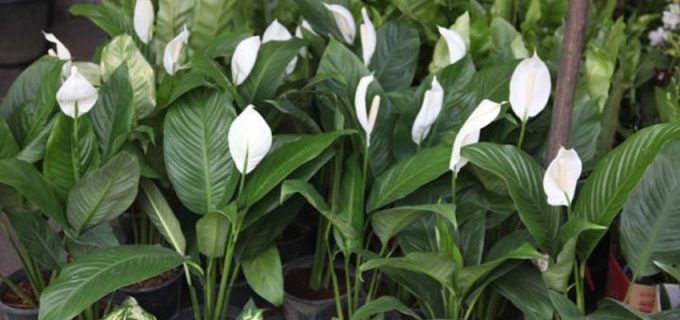

"Alana"
This decorative variety is widely used in the design of offices, housing, verandas and loggias. She has no stem. Reaches a height of 50 centimeters.
Glossy dense leaves are directed upwards. The ear of the inflorescence covers the white leaf of the flower, on the inside of which there is a raised green vein. Gradually, the bract inside changes its color to green. Alana blooms usually in April for 3-4 weeks. With proper care, the plant will produce flower stalks twice a year.
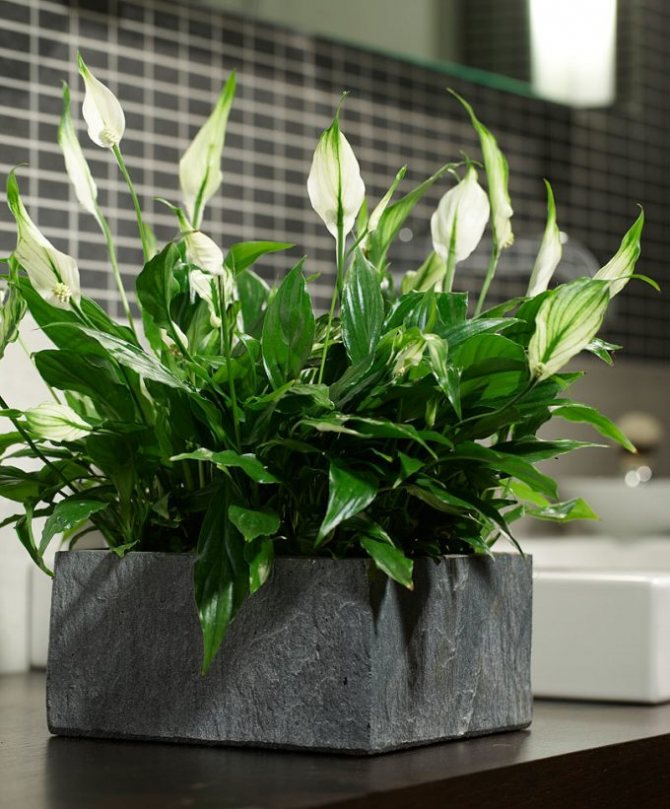

Chopin
This variety is unpretentious. It not only serves to decorate an office or living space, but also perfectly purify the air in the room. This species was brought to the territory of Europe from South America. There he grew along the banks of forest reservoirs. The shrub is low. He practically lacks a stem. It seems that the leaf mass begins to grow directly from the soil.
The dense leaves are oval with a slightly pointed top. The short peduncle ends in a white veil flower that emits a delicate aroma. This type does not require special conditions of detention, therefore it is widely used as a "green decoration" of premises.
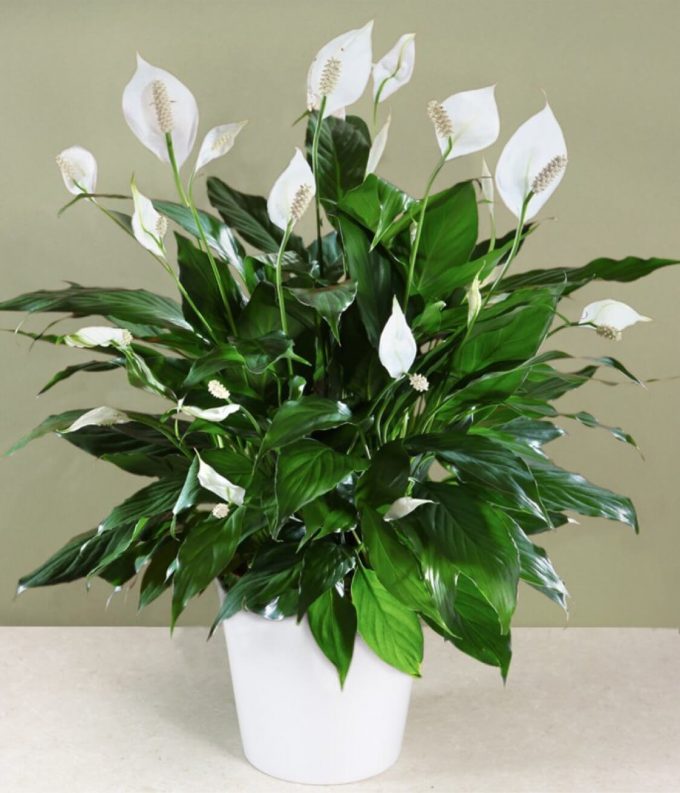

Wallis
The flower got its name in honor of Gustav Wallis, who was the first to discover spathiphyllum bushes in tropical forests. Breeders use it to develop new ornamental varieties. Plant height does not exceed 40 centimeters. Long, pointed at the ends of the leaves are located on high petioles.
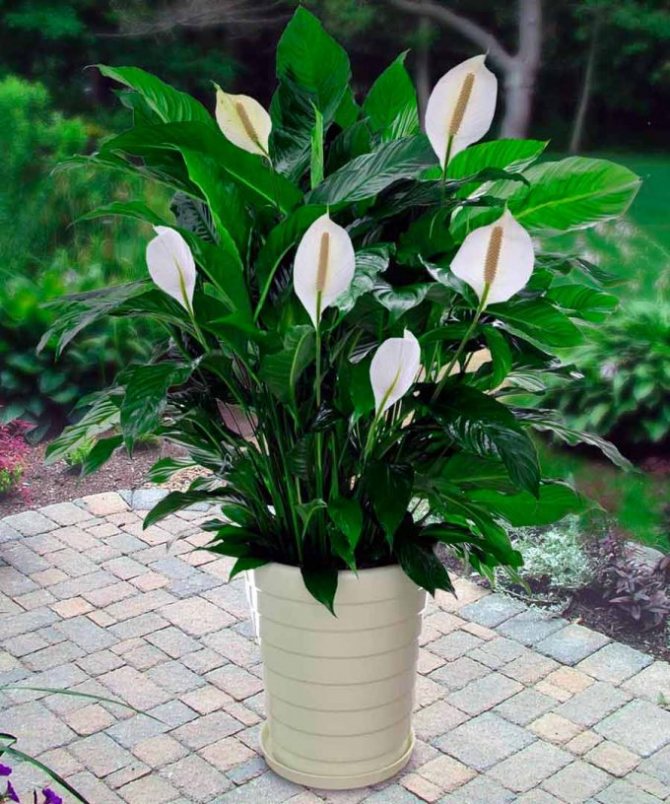

This species blooms from early spring to late autumn. During this period, the green bush is covered with numerous flowers, the size of each of them does not exceed five centimeters. White "bedspreads" gradually change their color to a green tint. The white ear of the flower is smooth. In the process of maturation, it acquires a creamy color, which turns into green at the very end of flowering.
Now read:
- Zircon for plant growth based on natural ingredients
- Planting to decorate the site with three types of conifers
- Description of 12 types of late varieties of cabbage for planting
- Exquisite junkus (sitnik) spiral in the interior
About
Chief agronomist of the Limited Liability Company "Association of Peasant (Farming) Farms" Kuznetsovskaya "", Ilovlinsky District of the Volgograd Region.
Spathiphyllum Chopin
This plant was first identified in topics. The sea coasts and the area along the forest rivers are an ideal place for Chopin's spathiphyllum, because this species is very fond of high soil and air humidity.
It is important to study the features of this type of "female happiness" from its congeners before purchasing it for your home or office. So, the distinctive external data:
- Height - no more than 40 cm.
- There is practically no stem, so outwardly it seems that the leaves grow immediately from the soil.
- Chopin's leaves are oval, bright green in color and have a pointed tip.
- The flower is white with green veins.
Like its relatives, Chopin's spathiphyllum is unpretentious. He needs a sufficient amount of diffused sunlight for comfortable growth and development. Partial shade can negatively affect the flower.
As for the air temperature, about 20-25 degrees is considered ideal for this type of spathiphyllum. The humidity should be at least 40%, so you need to spray the flower at least three times a week.
The soil should always be moist. To maintain optimal humidity, it is necessary to water the plant 4 times a week in the summer, and 1 time in the winter.
Chopin blooms, as a rule, from April to September. During this period, it is necessary to fertilize the plant and loosen the soil. This will help improve oxygen access to the roots of the plant. A quarter of the substrate for this type of "female happiness" should consist of peat.
Young Chopin (up to 4 years old) needs an annual transplant. This must be done very carefully: a flower is transplanted into a new bud together with an earthen lump so as not to damage the roots. It is better to transplant in the spring. After four years of age, the flower can be transplanted once every 4 years.
Landing
There are two ways to plant a new flower.
Using the offshoots of the mother bush
- It is necessary to spill the flower pot with water.
- Carefully remove the earthy ball and set aside for a short time.
- Carefully examine and carefully separate individual seedlings.
- Plant them in pots slightly larger than the length of the roots.
- At the bottom, you need to add expanded clay, fill the top with nutritious soil, install the plant and add the rest of the soil.
Seeds
The first step is choosing a pot. Anyone is suitable - if you chose ceramics, then inside it should be glazed. It is necessary:
- Prepare a pot or other container.
- Prepare the soil - you can buy ready-made in the store, or you can prepare it yourself by combining in equal parts: sheet soil, sand, peat, turf and charcoal.
- Fill the container with soil and moisten it ..
- Sow the seeds or simply press the seeds into the soil. Place the container in a bright place, covering it with glass to maintain moisture.
- Maintain a constant temperature in the room within the range of 24 to 25 * C.
- From time to time it is necessary to lift the glass for airing, so that stagnation does not form and mold does not appear.
- After the first shoots appear, you need to continue to air the makeshift greenhouse in order to harden the seedlings.
- When the seedlings reach a height of 3 centimeters, they are planted in small cups. When the height of the seedlings reaches 6 centimeters, they are transplanted into larger cups and placed in their permanent places.
After 3 months after the last transplant, the plants are fed.
Spathiphyllum dominoes
No fan of indoor plants remains indifferent after seeing at least a photo of Domino's spathiphyllum. This plant is considered rare among all representatives of this species. In addition to the famous unpretentiousness of spathiphyllums, this flower has another advantage. It has variegated bright foliage with various spots and touches of white.
In size, this is a small plant, which reaches a height of no more than 35 cm. This variegated handsome man, like its similar relatives, feels great in well-lit places, but direct sunlight has a bad effect (the plant begins to wither). Therefore, in order to admire this flower, provide it with partial shade, regular watering and protection from drafts.
Another feature of Domino is a light pleasant aroma that can be felt in the morning hours. By lunchtime, the smell either disappears completely, or becomes subtle.
Growing at home
In nature, culture grows where it is humid and warm throughout the year - in wet meadows, near rivers, in forest swampy areas. Daytime temperatures there are kept within the range of 22-28 ° С, at night they do not fall below 18 ° С. Being in the lower tier of the tropical forest, spathiphyllum has adapted to diffused lighting, acquiring long and wide leaves.
In order to get enough nutrients in poor tropical soils (most often acidic), where the thickness of humus is small, the roots grasp the upper layers, lying horizontally.
When growing indoors, you need to try to create similar conditions for it so that it blooms. If there is little moisture, it is cold, then flowering will not come.
Lighting
For a flower, you need to choose a place with diffused lighting, where there is no direct sunlight, leading to a leaf burn. Monochromatic varieties feel good in a slight partial shade, and variegated light needs a little more. You can put the pot on the west or east window, if this is not possible, then next to the south one.On the north window, the foliage and flowers become smaller, the bush loses its decorative effect. In winter, when there is a lack of light, a backlight is installed.
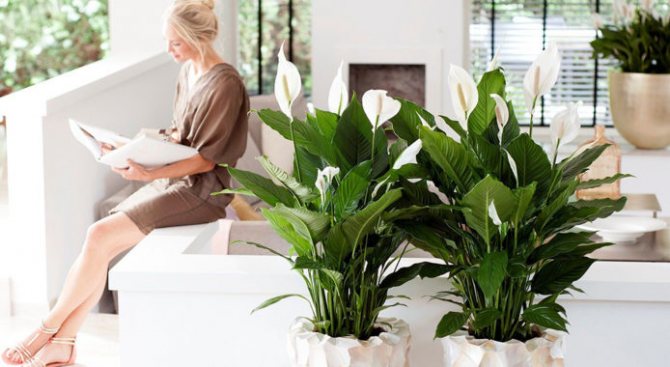

Humidity, temperature
In the tropics, humidity is high throughout the year, so it is necessary to maintain its level in the room within 80-90%. To do this, spray the plant 1-2 times a day, arrange a warm shower once a month, place containers with water next to it, put moss, pebbles in a tray and add water. In winter, place the plant away from heating appliances. Flowers must be protected from water droplets falling on them - lingering in the depressions, they lead to decay.
In spring, the temperature regime should be moderate - 20-22 ° C, in summer and autumn, the culture tolerates heat well, if you observe the irrigation regime and humidify the air. You can take the pot out to the terrace, balcony. In winter, the optimum temperature is 18-20 ° C. Avoid contact of leaves with cold glass, the ingress of cold air on them when ventilating, drafts.
Irrigation mode
Like any tropical plant, spathiphyllum does not tolerate a lack of moisture, so watering should be regular. In the summer and spring, it is necessary to water when the top layer of the soil dries up, the interval is about 3-4 days, in the fall and winter the need for water is less, therefore it is watered less often and in smaller volumes - once a week.
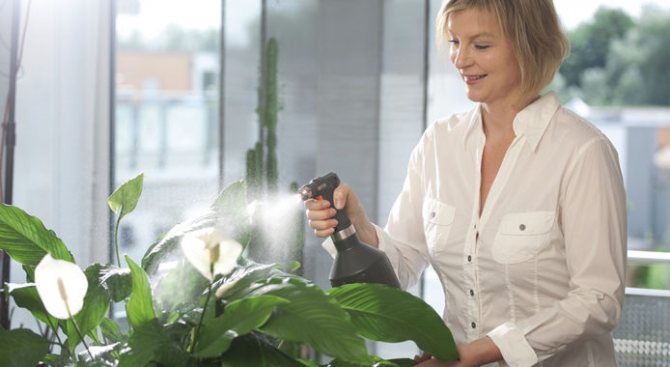

Water for irrigation should be settled, at room temperature, so that there is no sharp contrast between the temperature of the soil and water.
Top dressing
You need to apply fertilizers to wet soil or dissolve them in water for irrigation, following the recommendations in the instructions.
During the active growing season (March-September), the interval between fertilizing is 10-14 days. Use:
- phosphorus-potassium mixtures in liquid form (without lime), for example, Pokon, Etissa, Ideal, Good power, dosage - 1-1.5 g / l;
- organic fertilizers - vermicompost (5 tbsp. l / l, insist 24 hours), mullein solution (1 tbsp. l / l).
In autumn and winter, when the activity of the processes decreases, they are fed every 3-4 weeks. If flowering has come, then you can use the same fertilizers as in the summer, the plant without flowers is fed with nitrogen fertilizers, stopping feeding about 30 days before the formation of buds.
Instead of fertilizers, before flowering, you can water with a solution of castor oil (1 tsp + 1 l of water).
Pests
The culture has a high resistance to infections and damage by pests. Of the pests, it can sometimes be affected by spider mites and aphids. Most often, this happens in the vicinity of an infected plant. Insects can be dealt with with a soapy solution, adding nicotine sulfate (a few drops) to it. The tool is applied with a sponge to the leaves, covering the soil with a film, left for a day, then washed off with clean water.
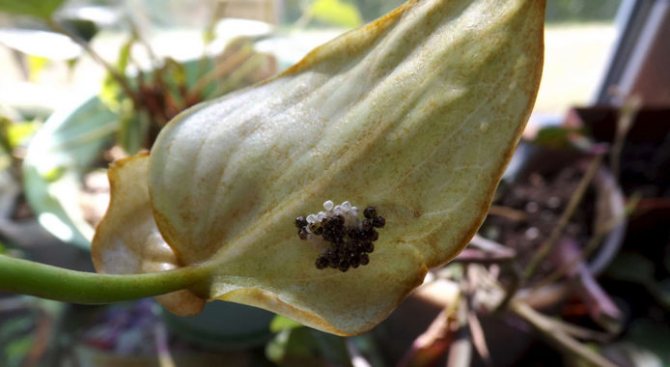

You can monthly, for the purpose of prevention, wipe the leaves first with soapy water without additives, then with clean water.
Winter holidays
Spathiphyllum does not have a pronounced rest period, but, as experience has shown, if it is arranged a short rest in January-February, then the flowering will be more abundant and longer. For 21-28 days, the flower is sent to a cool (16-18 ° C) shaded place, moistened by spraying (to prevent the soil from drying out), fertilizers are not applied.
Spathiphyllum Picasso
This species was obtained with the assistance of Dutch breeders on the basis of Wallis spathiphyllum. Therefore, this plant is even more colorful and unusual. Its peculiarity is that there are whole sectors of white color on the leaves. Picasso is the perfect plant for those who love unusual bright indoor flowers who need minimal maintenance.
This species, like all spathiphyllums, makes only one mandatory requirement for care - lighting. It should be bright, but not scalding. It should be noted that in Picasso not only the foliage has such a variegated color, but also the perianth with a sharp tip.
Where to get planting material?
You can buy a seedling in the store, the price starts from 50 rubles.You can also ask your friends for a seedling. Usually they are separated from the adult plant during a planned transplant.
It is easier to purchase seeds in an online store, the cost of a 0.06 gram package starts at 150 rubles, but you can also collect them yourself. After flowering and ripening, the seeds are planted in a pot in the spring, and dive after germination.
It is necessary to remember about the germination times, they are very short in spathiphyllum.
Spathiphyllum Cupido
In Holland there is a kennel Cupido, which is engaged in the study and selection of spathiphyllums. The species of this plant have become so popular among indoor plant lovers that the new species derived from Wallis's spathiphyllum was named Cupido.
This species has bright green leaves and white inflorescences that have a graceful curved shape. Cupido is an unpretentious plant, like the rest of the spathiphyllum, so it is not difficult to take care of it, and it will delight you with its appearance for many years.
How to propagate
The seed method of reproduction at home is not used, because the full maturation of seeds is rare, the germination is poor, the shelf life is limited in time. Cuttings are also not popular due to the inability to create conditions at home for germination and rooting of cuttings.
The easiest way to propagate a flower is to divide the bush during transplanting by cutting the root into several pieces. Each section should have several leaves. After processing the sections with Kornevin, plant each bush in a separate container.
An unpretentious ornamental plant - spathiphyllum, easy to breed at home. The flower quickly assimilates in the apartment and office space, not requiring a lot of light and complex care. A little attention, care - and he will thank him with a long, abundant flowering.
Alana's Spathiphyllum
Spathiphyllum Alana is an ornamental plant that is popular for its bright foliage and delicate flowering. It is very convenient that this flower is perfect for both home and balcony, and for the office.
Alana is a flower of the Aroid family. The tropics are considered the homeland. The absence of a stem is the main feature of this species from all the others. Flower length reaches 50 cm. Leaves are dense, glossy. Another exceptional feature of Alana is the color of the bracts. On the inner side of the white bedspread, starting from the period of growth and flowering of the flower, there is a convex green vein. When the plant fades, the green color covers the entire surface of the bracts.
As for the leaves, they also have their own characteristics compared to other spathiphyllums. The tips on Alana's foliage are directed upward, and not curved, like many other representatives of the species.
An inflorescence-ear, wrapped in a white delicate veil, acts as a flower. Alana begins to bloom in the spring, and flowering lasts about two to three weeks. If you carefully follow all the rules of care and provide the plant with comfortable conditions, then it will delight you with its flowering twice a year.
Distinctive characteristics
The culture belongs to the genus of evergreen perennials (Aroid family) that grow in regions of Central and South America, the Philippines, the Moluccas, and New Guinea. Its rhizome is superficial, filamentous, occupies the upper layers of the soil, giving rise to a bunch of intact basal leaves on an elongated petiole. The average height of the bush is 30-45 cm.
The leaf plate is solid, lanceolate or oval, with a pronounced central and lateral veins. As it grows, a depression (vagina) forms near the petiole, through which moisture flows down. The color depends on the species and comes in various shades of green, with white or yellowish spots.
Nondescript pale yellow, cream or greenish small flowers are collected in a dense cob inflorescence on a long thin peduncle. The ear is "wrapped" in a snow-white blanket, contrasting with the dark foliage.Blooming spathiphyllum does not shed the bracts for a long time, gradually changing color from white to white-green. Flowering occurs most often once a year.
The Greek word Spathiphyllum consists of two words - spathe + phyllon, which translates as "cover" + "leaf" and reflects the characteristics of the plant. Along with the scientific name, others also circulate - a flag-leaf, it is called a white sail because of the similarity of the bracts with a waving flag, a sail.
Spathiphyllum Sensation
Spathiphyllum Sensation - a type of flower "female happiness", which is now considered very popular and one of the most common. There are two main qualities that distinguish Sensation from other spathiphyllums:
- Patience for low light. This flower can feel great away from the window and in apartments on the north side, which increases its popularity at times.
- Gigantism. The sensation is considered the largest representative of all spathiphyllums that can be kept in a room. On average, its size is about 1 meter, and some can reach a length of up to one and a half meters.
For the first time, the Sensation was brought out by flower growers from Holland. When breeding it, the main goal was to create such a flower that will easily decorate any large room in which there is very little sunlight: an office or a hall. Again, Wallis' spathiphyllum was used as the original flower.
So, it has already been noted that this is a large flower. Its leaves reach about 50 cm in length.And adults, perennial representatives of the Sensation can boast foliage up to 80 cm long, and at the same time about 40 cm wide.Such large leaves look very decorative: a rich green color, a slightly corrugated shiny surface will not leave indifferent anyone. Each individual leaf is supported by a long but sturdy petiole, which bends over time, which causes the leaf blade to droop slightly.
When the Sensation blooms, a powerful large peduncle rises above the plant. The characteristic ear is surrounded by a large white blanket. Over time, the color of this bedspread becomes greenish, and then completely green and, in the end, merges with the leaves.
This plant is considered very popular among many housewives, not only because of its excellent decorative properties, but also because of the unpretentiousness that all spathiphyllums possess.
Possible problems
When growing a thermophilic tropical flower, problems sometimes arise due to improper care. They can be avoided if you know the reasons leading to them.
Problem, reasons, how to eliminate:
- leaves turn yellow and wither (lack of moisture, low humidity in the room, exposure to direct sunlight) - put the pot in a bowl of water, when the soil is soaked, get it out, drain the excess, spray it 1-2 times a day, change the place;
- dark spots on the leaf plate (roots begin to rot due to excess moisture) - cut off diseased roots, transplant the plant, making the drainage layer thicker, observe the irrigation regime;
- dry tips on the leaves (there is not enough nutrients, the air is cold or too dry in the room) - apply fertilizers regularly, as described above, moisturize by spraying;
- does not bloom (little light, large pot volume, did not give rest, there is a lack of potassium and phosphorus in the soil) - create the necessary conditions.
History of creation
The origin of this culture is Holland. Our hero was obtained thanks to the hard work of breeders. As a starting material, they took another species - Wallis' wild spathiphyllum.
On the territory of this European state, this culture is grown on an industrial scale on plantations of garden farms. In particular, Domino was supplied to our country until 2008 in large quantities and was almost always on sale.But over the past year, its acquisition has caused certain difficulties, since it is not possible to find this variety. There is information that for some reason this variety is no longer grown in the Netherlands.
Signs and superstitions
It is believed that if spathiphyllum gets into the house, then women will find happiness: unmarried people will get married, married people will find harmony in relationships.
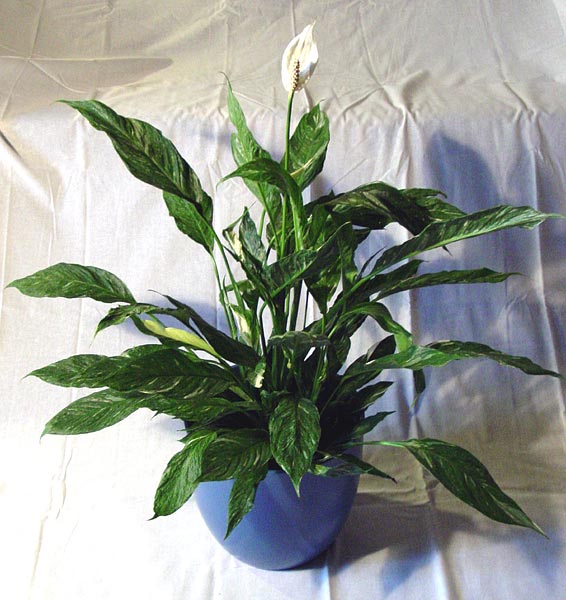

Spathiphyllum Domino in a pot
Additional Information. The flower will help to find understanding with a partner, as well as eliminate all quarrels between residents of the house of different age categories.
When caring for spathiphyllum, you need to adhere to all the rules of cultivation, then it will delight with snow-white flowers and an amazing aroma for a long time.
Scherzer's Anthurium
The main difference between this species is its small size and rather unusual ear. On the pedicel, which reaches half a meter, an unusual inflorescence appears - a spirally twisted, slightly elongated, orange-red ear, about eight centimeters long. The bedspread is usually thick, almost round, and bright orange in color. The stem is green and short (no more than 15 cm in height).
Anthurium Scherzer has luxurious leaves: pubescent on both sides, leathery, dark green, oblong with a pointed end. In a flower pot, up to eight flowers bloom at once, which last up to three months. The flowers have a pleasant aroma.
Of the decorative deciduous anturums, three varieties are most often grown - Majestic, Crystal, Rassechenny.
Anthurium care
Care must be taken with this plant: anthurium must be placed in places inaccessible to children and pets. All parts of the flower are poisonous, especially the young leaves.
Despite the fact that anthurium is a tropical plant, it does not tolerate direct sunlight. The plant feels most comfortable on the east or west window. Backlighting is required in winter. Without it, the plant is unlikely to bloom.
Potting mixes designed for succulents are suitable for anthurium. The pot for him should not be very large, but with a good drainage layer. If you decide to prepare the mixture yourself, then mix humus, leafy soil and peat in equal proportions. Then add some sand. The soil for this plant must be slightly acidic, and mineral complexes must be used for feeding.
Active growth occurs from March to September. At this time, you will need feeding for flowering plants. From October to February, during the dormant period, it is necessary to use fertilizer for ornamental indoor plants, but the standard dosage must be halved.
Transfer
Once a plant has been purchased from a flower shop, it cannot be left in the same pot. The fact is that store soil contains an insufficient amount of nutrients. Therefore, the flower must be placed in another container with pre-prepared soil. In addition, a transplant may be necessary in some other cases:
- if the plant has grown, it needs to be propagated;
- there are signs of any disease.
Spathiphyllum Heliconiophyllum
The homeland of this beautiful plant is the rainforests of Brazil. This flower grows up to a meter in height. Leaves are elliptical, up to fifty centimeters long and about twenty-five wide, glossy, dark green, wavy at the edges. The petiole is up to 90 cm long. The inflorescence is a white ear, about 10 centimeters in length, which eventually darkens to almost black.
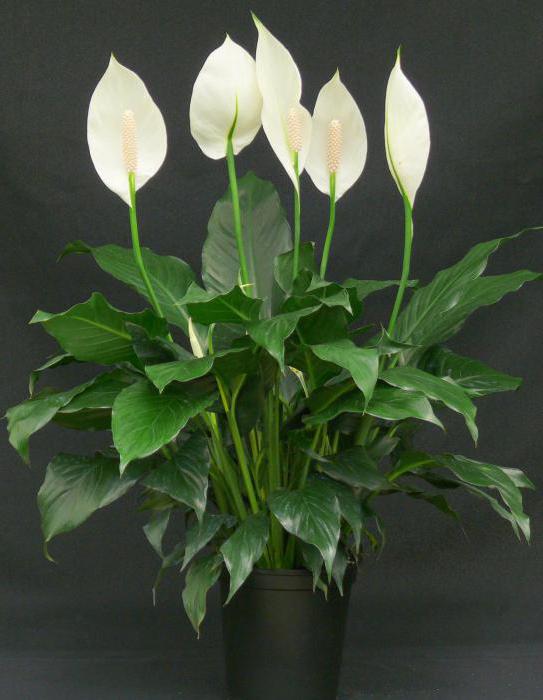

The oval cover is almost twice as long as the white cob. This is a magnificent type of decorative spathiphyllum, which is successfully grown indoors.
How to care?
Each plant requires care in order to delight the owners with full and active growth.Spathiphyllum "Domino" is no exception, although it is a rather unpretentious culture in this regard. It is required to carry out a number of manipulations, for example, moistening the soil and feeding, which is necessary for timely flowering.
We must not forget about watering. How often you need to produce it will depend on the time it takes for the top layer of the earth to dry out. On average, the frequency of watering is 2 times a week in summer and is reduced to 2 times a week and a half in winter. You should use water, settled for a couple of days, at room temperature.
The plant should be watered carefully, trying not to get on the stems and leaves.
As for dressings, fertilizers should be applied once every 2 weeks in spring and summer. In autumn, one procedure per month will be enough for the plant. Spathiphyllum should not be fed in winter, as well as during flowering. As for the composition of fertilizers, organic mixtures are perfect for which you can use poultry manure or mullein, as well as products containing phosphorus and potassium. If you oversaturate the plant with nitrogen, it stops blooming, giving all its strength to the development of greenery, so feeding should be done according to a previously prepared schedule.
It should be borne in mind that fertilizers must be diluted exclusively with boiled water. Before adding them to the soil, you need to moisten its top layer using a spray bottle. The drug itself is added exclusively to the ground, without touching the leaves. At the end of the procedure, you need to moisten the soil with water again.
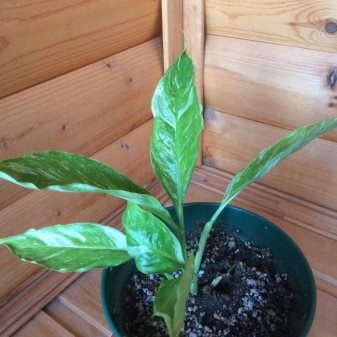

Another important procedure that should not be neglected is plant pruning. It is carried out after the spathiphyllum has faded. Withered peduncles are cut with a sharp knife as close to the rhizome as possible, and the wound must be covered with wood ash, which should be crushed in advance.
It is also necessary to monitor the appearance of dry and sluggish leaves, which are removed by hand.
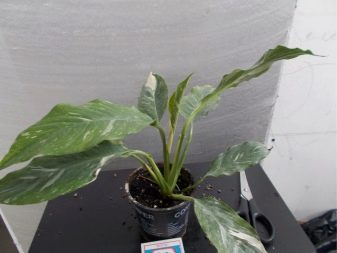

Breeding options
Spathiphyllum can be grown from seed or propagated by rooting cuttings or dividing a bush.
Picture 7 Spathiphyllum Domino in a pot
Germinating seeds
Plant seeds are laid in a prepared substrate, consisting of garden soil and river sand. The plantings are covered with foil and left at a temperature of + 18-20 degrees. When the first shoots appear, the temperature is lowered to + 10-15 degrees. Water as the top layer of the earth dries up.
Rooting cuttings
Young stems are selected from the bush and cut at right angles. All leaves are removed from the bottom, treated with a root growth stimulant and planted in the ground. During the rooting period, the planting is covered with a film. When the cuttings take root, you need to remove the shelter and care for it like an adult plant.
Part of a bush
The bush is removed from the pot and divided into several parts. Further, all parts of the bush must be transplanted into new pots and watered well. Apply the fertilizer after 1 month.
Priming
The main component of the soil is turf, peat, leafy soil, humus, sand, sphagnum, hydrogel granules are added to it.
Photo
Next, you can see a photo of the flower:
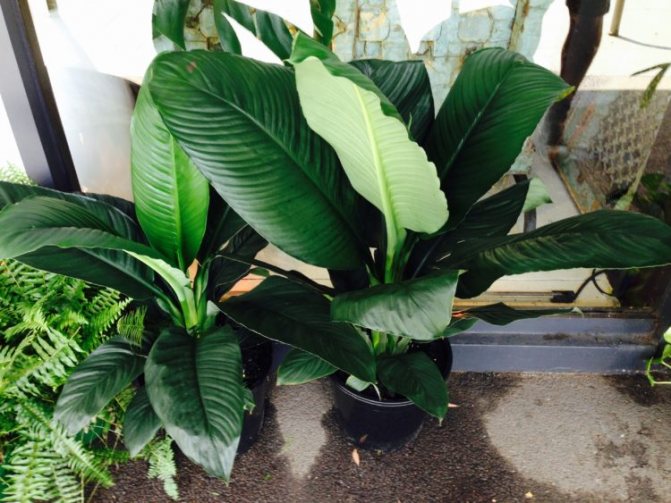

Possible growing problems
Although Domino's spathiphyllum is unpretentious in care, the following troubles can occur with it.
Drops buds and leaves
The spathiphyllum gets sick from the draft and sheds its leaves, you need to protect the plant and not put it on the windows that open for airing in winter.
Leaves turn pale
With a lack of complex mineral fertilizing, the flowers on the plant will shrink, the leaves will turn pale and slow down growth.
The tips of the leaves dry
The reason is dry air. It is necessary to constantly spray and use a humidifier. Also, yellowing of the leaves can be observed when watering with hard water or due to insufficient moisture in the soil.
Lack of flowering
The reason is not enough light, watering or fertilization. You also need to remove faded inflorescences in a timely manner.
The lower leaves fall away
The reason is the presence of insect pests.It is necessary to process the bush with tobacco crumbs.
Pests
Most often, the flower is struck:
- Spider mite - apply insecticides;
- Shield - treat with tobacco crumbs;
- Aphids - use chemicals;
- Mealybug - treat the leaves with alcohol.
What is the difference from other species?
Spathiphyllum Domino is a variegated form. Due to the special infection of the flower with the variegation virus, the color of the foliage is uneven.
Reference! If you make a comparative analysis between varieties such as Domino and Gemini, you can see that the difference lies in the bracts, which have an oval shape. The similarity between them is in the spots on the leaves.
You can read about other varieties of this beautiful flower in a separate article.
Reproduction
Cuttings
Procedure:
- Choose strong, bright green stems. Cut them into cuttings with two buds each.
- Activated carbon powder helps prevent the development of diseases. Sprinkle it on the slices.
- Lay the cuttings on top of moistened peat.
- Cover pots with planting material with cling film to create greenhouse conditions. Wait 1-2 weeks for the cuttings to take root.
- As soon as a root mesh has formed on them, transplant into separate containers. Wean spathiphyllum from the film gradually so that it does not die from stress.
Seeds
Procedure:
- Prepare a pot and plastic wrap to create a mini greenhouse.
- Prepare a sand-peat mixture in a 1: 1 ratio. Pour it into a pot with drainage, and then sow the seeds to a depth of 3-3.5 cm.
- You can see the first shoots one month after sowing. Throughout this time, open the film every day and water the soil as it dries.
Diseases and pests
Root decay remains the most common disease. The main reason is the disturbed irrigation regime. With a severe defeat, the plant can no longer be saved and will have to be thrown away. But pests love to feast on juice and green parts of the plant. The most common are:
- Spider mite. It is easy to notice the pest, as it envelops each leaf with a thin web. To combat it, a soap solution is used. In case of severe infection, insecticides are needed.
- Shield. This parasite is the most insidious, as it can destroy the flower. If convex spots are found on the inner side of the leaf, move the plant to quarantine, placing it away from other crops. Rinse the leaves in soapy water and treat with tobacco crumbs. Remove all elements affected by the pest.
- Aphid. To combat the pest, carry out repeated processing of the leaves using special chemicals.
- Mealybug. It is located between the leaves and upon close examination, it can be easily detected. To eliminate single parasites, use alcohol cotton, and in case of severe damage, chemical agents are suitable.
Content rules
Plant care does not require special knowledge and skills. Spathiphyllum is unpretentious to environmental conditions and easily tolerates temporary inconveniences. However, for abundant flowering and good growth, the following rules must be followed:
- Diffuse light or partial shade;
- lack of drafts;
- temperature regime;
- periodic spraying;
- timely watering.
In places where the sun's rays penetrate, you should avoid hitting the pet's leaves to prevent burns. At the same time, it is necessary to provide the "white sail" with enough light, since with a lack of lighting, its leaves become small and inexpressive.
The air temperature prefers room temperature, about 22 degrees Celsius, but it rises at a lower temperature. In cold rooms, where the air does not warm up above 16 degrees, it can stop growing and get sick.


A prerequisite for health and flowering is an increase in the humidity of the surrounding space. In the spring-summer period, spraying of the plant is carried out 2 times a day.A good solution would be a container with a small layer of expanded clay or pebbles, in which a flower pot is placed.
The amount of watering depends on the season and the stage of development of the "white sail". During flowering and intensive growth, the amount of water is increased. In the autumn-winter period, watering is done sparse and moderate. The water temperature must be at least 18 degrees. It is necessary to monitor the excess moisture in the pot and avoid stagnation.
Despite good immunity, spathiphyllum can be attacked by the following pests:
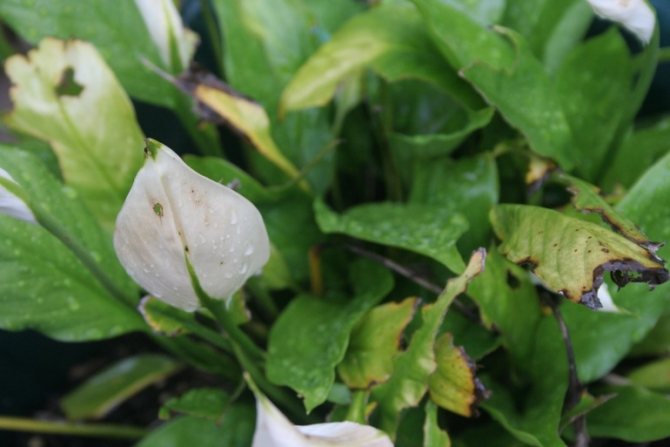

- Mealybug;
- aphid;
- spider mite;
- shield.
If you don't fight them, the flower will die. If insects are found, it is necessary to treat the plant with insecticidal preparations, and a warm shower is suitable as water procedures. When damaged by pests, the leaves of the spathiphyllum become covered with dark dots, turn black and die off.
Of the diseases that can destroy the "white sail", the most dangerous are late blight and root rot. To prevent these pathologies, you need to monitor the moisture content of the soil, avoiding its overabundance. Treatment with "Fitosporin M", "Alirin B", "Planriz" is mandatory.
The lack of flowering may be due to a lack of fertilizer or moisture. It is also important to remember the age of the plant: it blooms after reaching maturity.
Reproduction and transplantation
Reproduction takes place in three ways: by apical cuttings, by seeds and by dividing the bush. The first two methods are inappropriate, since “female happiness” gives enough offspring. When it appears, the bush is divided into parts so that sprouts and roots remain on each of them.
The planting container should not be too spacious... Excess space in the pot promotes intensive root development, which leads to poor flowering up to its complete cessation.
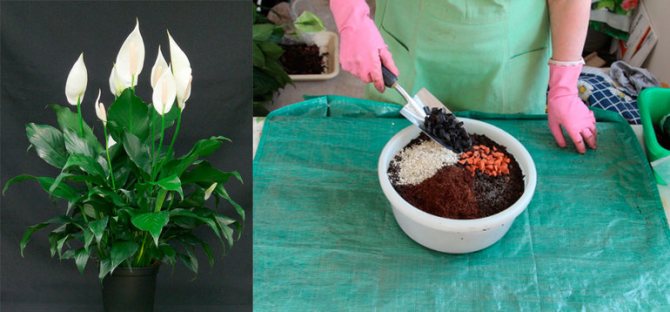

Humus, peat, leafy soil and sod are placed in the soil... As additional components, a mixture of hydrogel granules, crushed sphagnum and sand is added. The turf in the soil should be 2 times larger than other elements.
During transplanting, care should be taken not to damage the rhizome. Brick chips and charcoal in small quantities are suitable for mandatory drainage.
Top dressing with fertilizers is carried out 2 times a month in the warm season, as well as during the period of growth and flowering. With the onset of winter, this procedure is limited to one time. Poultry droppings and preparations for indoor flowers are well suited as organics.
Useful qualities
Spathiphyllum is a phytoncidoactive plant. It cleans the air from carbon monoxide, formaldehyde, acetone and other substances harmful to health. Large foliage releases enough ozone to make it easier to breathe in the room. In addition, "female happiness" improves attention and performance, so they are often decorated with offices and rooms for schoolchildren.
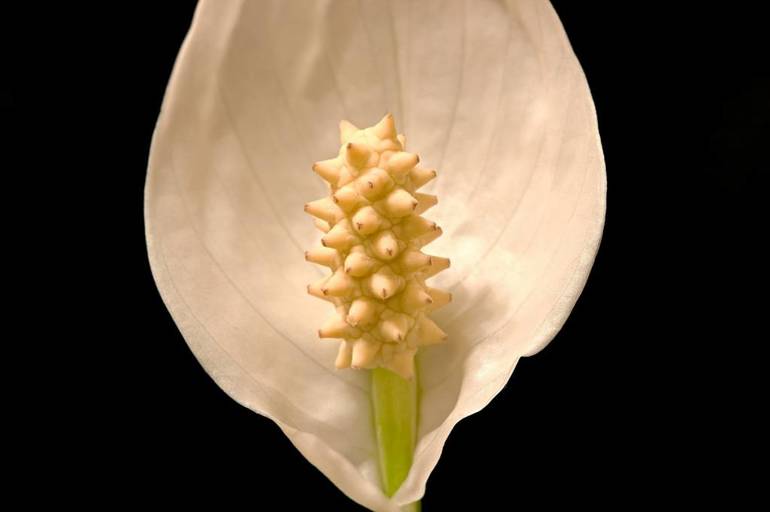

"White sail" is often used as a decoration for living areas in kindergartens. In this case, a plant passport is drawn up, which contains illustrations and a brief description of the evergreen pet.
When placing a flower in an apartment, it is important to remember that its juice is poisonous. Once on the mucous membrane, it causes salivation, burning and pain in the stomach. Therefore, care must be taken to ensure that it is not accidentally eaten by pets and small children.
Purchase recommendations
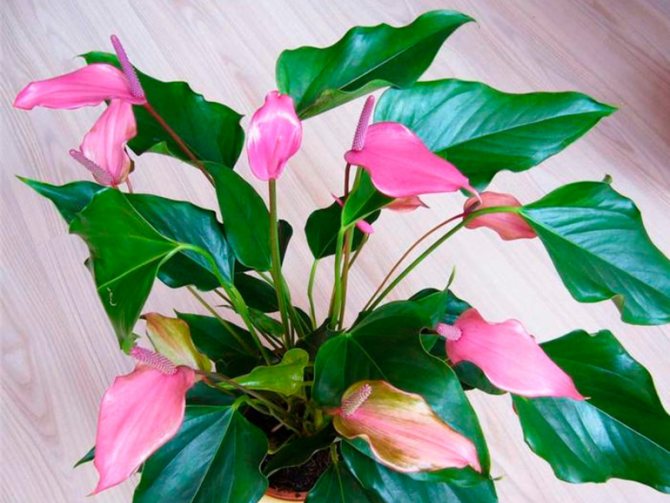

All flowers look well-groomed and healthy in the shop windows. However, before acquiring "female happiness" it is important to adhere to several recommendations. Inflorescences and shoots, leaves and soil require close attention.
The leaf plates should be free of damage, yellow and dark spots, and other defects. A healthy plant has dense, juicy and glossy foliage. Perianths, inflorescences and petioles without signs of drying out. The presence of mold, unpleasant odor, excess water, cobwebs is unacceptable in the soil.A close inspection will help you grow a beautiful and healthy plant.
How to determine which class a flower belongs to?
Attention! All domestic species and varieties of spathiphyllum are so diverse that sometimes it is very difficult to distinguish between them.
But there are certain secrets that will help you understand what this species is:
- They all differ in height and are divided into two large groups: giants and miniature ones.
- Flower shape.
- The shape and color of the leaves.
But there is one common feature they have - this is the color of the flower, which remains white in all types of spathiphyllum.
Anthurium
And now it's time to find out what "male happiness" looks like. Often, next to the spathiphyllum, another beautiful flower is placed - anthurium. Quite an unusual bright plant with an original shape that attracts and bewitches. Because of its interesting appearance, the flower has received many popular names - "Devil's Tail", "Artist's Palette", "Pig's Tail" and, of course, "Man's Happiness". Florists believe that this flower brings good luck and prosperity to the stronger sex.
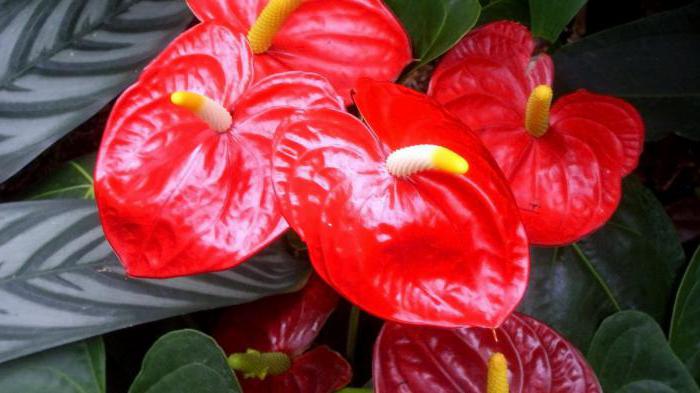

Anthurium and spathiphyllum, planted in one pot, look luxurious: the bright red flowers of the first plant and the delicate snow-white flowers of the second create a spectacular combination, shaded by a dark green background of chic leaves. Below we will present you the most common types of this plant.
Description
Spathiphyllum Domino is a hybrid that was obtained as a result of breeding work. Its name is translated from Latin as "veil" and "leaf".
This type of spathiphyllum grows up to 17 cm. It has an ear located on a peduncle, which is wrapped in a white sail.
Reference! As soon as the plant has bloomed, the sail does not fade, but acquires a green color. If a withered flower is cut immediately, then a new one will appear much earlier.
The peculiarity of this variety is in a variegated leaf plate. The main color is dark green, and white and light green spots and stripes are scattered over it. The shape of the leaves is oval. They are so beautiful that the bush, even without flowers, looks spectacular and beautiful.
Location and lighting
To make the plant feel comfortable, experts recommend placing it in rooms facing north or south. Shaded areas should be avoided, since the culture is very fond of light, the lack of which can lead to a lot of problems, for example, deformation of the leaves and a change in their color. Moreover, you should carefully monitor the absence of drafts, since the flower may simply die from them.
If the pot with the plant is placed on a windowsill on the south side of the house, you need to take care of a little shading. Direct sunlight can also cause significant damage to the plant.
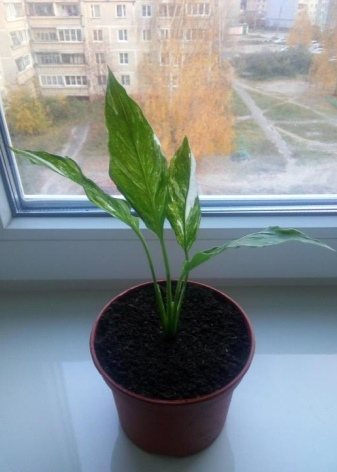

What depends on the type?
When growing spathiphyllum, you need to know what species it belongs to... After all, the conditions of detention depend on this. Spathiphyllum are unpretentious, but some species are quite capricious. For example, cannoli spathiphyllum will simply drop the entire leaf mass to dry out an earthen coma. But spathiphyllum mini will respond to waterlogging of the earth by rotting roots.
All spathiphyllums do not tolerate direct sunlight, drafts, they do not like large temperature drops - which is why they are not transferred to the balcony in the summer. Most spathiphyllums require high humidity and regular spraying. You need to take into account the size of the view.
Spathiphyllum giants will be more appropriate in a spacious room., dwarf species will perfectly fit on the window sill.
What groups are there?
- Fancy.
Unusualness can be expressed in the shape, color of the leaf:- Spathiphyllum Silver Rain dwarf.
Spathiphyllum Domino.
- Easy to care for.
For beginners in the cultivation of spathiphyllums, it is better to pay attention to the easy-to-care varieties:- Spathiphyllum Angel Baby.
Spathiphyllum Spilt Milk.
- Spathiphyllum Mauna Loa.
- Spathiphyllum Wallisii.
- Expensive.
The expensive varieties of spathiphyllum include varieties of rare, unusual, large species:- Spathiphyllum cochlearispathum Sanny Sails yellow.
Spathiphyllum cochlearispathum Sanny Sails white.
- Spathiphyllum Deli.
- Spathiphyllum Sensation.
- The most difficult to care for.
Among the unpretentious counterparts, there are species that require increased attention to air and ground humidity, lighting:- Spathiphyllum cochlearispathum.
Spathiphyllum floribundum.
- Spathiphyllum floribundum mini.
- Spathiphyllum Picasso.
- Rare.
- Spathiphyllum Lemon Glow.
- Spathiphyllum New One.
- Large.
The largest spathiphyllums are impressive in size: they form bushes up to 1.5 m high, up to 2 m wide, leaf size up to 80 cm long, up to 40 cm wide.- Spathiphyllum cochlearispathum.
Spathiphyllum Sensation.
Origin story
For the first time, the plant was told by the German scientist Gustav Wallis, who discovered the flower during a scientific expedition to the tropical forests of Ecuador and Colombia. It is these countries that are considered the birthplace of spathiphyllum, an indoor plant. The opening took place at the end of the 19th century. The name of the discoverer is the most popular type of spathiphyllum, better than others adapted for home cultivation.
Collectors traveling through the South American jungle have gradually found other species of this plant. At first, it was bred in the royal gardens of Britain, from where it began to spread throughout Europe and Russia. In the middle of the 20th century, breeders bred new varieties of "female happiness".
The name spathiphyllum consists of two Greek words that translate as "covering leaf"... In different countries it is called differently: in Europe - "lily of the world", in America - "flag bearer", and in Russia "female happiness" or "white sail" for its resemblance to the subject of ship equipment. According to legends, a flower helps single girls get married as soon as possible, women - to preserve love and harmony in the family, and childless families - to wait for offspring.
Distribution in nature
Despite the fact that the flower is native to the countries of the South American continent, some of its species are found on the islands of Indonesia and Melanesia, in Southeast Asia. He prefers swampy soil near river banks, a humid climate with a stable air temperature.
Its natural habitat is limited to the lower tier of the rainforest. There are species that have adapted to the epiphytic lifestyle on tree trunks. This behavior is due to a lack of sunlight.
Description of the plant
"Female happiness" belongs to the aroid family. The main feature of spathiphyllum is its absence of a stem. This structure is explained by the living conditions in nature. The lack of light is due to the fact that spathiphyllum grows in the shade of tall thickets. Therefore, the plant has formed large leaves that help it with photosynthesis.
The soil in the tropics is slightly acidic, there are few nutrients in it... There is not enough plant debris in the humus, as they are washed out by rainstorms or taken up by the roots of large trees. For this reason, a horizontal rhizome is formed in spathiphyllum to search for nutrients in the upper part of the soil.
Oval or lanceolate leaves grow directly from the soil... From there, an arrow grows, on which the inflorescence is located. It resembles an ear of corn surrounded by a white blanket.
Such a structure is necessary for the flower to attract insects that pollinate the plant.
Varieties and types
Spathiphyllum has about 50 species, the most unpretentious of which are grown on windowsills:
- Domino is a bush 0.5 meters high. The coloring of the leaves is very unusual - the dark green background is painted with white spots, strokes and stripes. In order for the pattern to remain bright, the plant is provided with good lighting. A yellowish flower with a snow-white veil. It has a subtle scent that appears in the morning and disappears by the afternoon.
- Cupido is a very interesting Dutch hybrid. It is attractive with long, curved petals, the pointed tips of which are dark green in color. It blooms in spring for one month. Feels good on windowsills facing east or west.
- Heliconiophilous species, which is native to the tropical forests of Brazil, has a decorative appearance and unpretentiousness.A bush with large oblong elliptical leaves. They are dark green in color with a glossy finish, wavy edges and a pointed end. The white ear gradually darkens, its size is 10 centimeters. The surrounding "sail" is twice as long.
- Adorable (pleasant) grows in the African jungle. The color of the leaves is dark green, the shape is lanceolate, the tip is drawn. The petioles are long and strong. The bedspread is greenish-white, shaped like a small flag. Abundant flowering begins in April and ends in June. Good care ensures the re-emergence of flowers.
- Spilt milk is one of the newer varieties. Interesting is the soft color of the leaves, the green color of which is combined with blurred light green and white shades. Because of this feature, it got its name.
- Haiti is a rare variety bred by Dutch breeders. The leaves are soft, leathery, covered with yellow patterns. Good because it can grow not only in soil, but also in pots with water. As an additional decoration, it is sometimes planted in aquariums.
- The canniferous species differs from its congeners in the color of its foliage - it is bright green. To avoid darkening, it is necessary to provide the flower with good lighting. In this case, direct sunlight should be avoided so that the plant does not get burned. There is enough diffused light. Blooming spathiphyllum exudes a pleasant scent.
- Picasso stands out for its unusual color of foliage. Intense white spots are found not only on the leaves, but also on the cob and perianth. Such motley coloring makes the hybrid unique against the background of its fellows. Needs abundant watering and diffused lighting.
- Abundantly flowering - a native of the tropical thickets of Colombia. It is equipped with many leaves and an underground creeping stem. Lanceolate leaves 25 cm long are located on small 15-cm petioles. Peduncles consist of a greenish flower surrounded by a concave cape.
- Japanese is an undemanding specimen. Oval leaves with wavy edges are bright green in color. Pleases with fragrant flowers twice a year. This variety needs a slightly acidic soil.
- Sensation is the largest hybrid up to one and a half meters high. The leaves and inflorescences are also large. A cape with a cob of snow-white color, but over time it turns green.
- Wallis is the aroid progenitor of many hybrids. It got its name in honor of the discoverer of spathiphyllum. The characteristic of this species contains common features with other varieties. It is the most common plant pet in apartments and offices.
A common misconception is the opinion about the color of the cape. In "female happiness" it is only white. A plant similar to the "peace lily" with a red veil is called anthurium. Despite belonging to the same family, these two plants have several differences. They consist not only in the color of the inflorescences, but also in the form of leaves, which are attached to the stem in anthurium.
This beautiful flower is often grown with the "white sail" and is called "male happiness". As a couple, they are believed to help strengthen the relationship between spouses.
Subsorts of this species
With yellow variegation:
- Strauss;
- Sunny sales;
- Milk;
- Haiti.
With white variegation:
- Dominoes;
- Picasso;
- Gemini.
How to distinguish from other species
Spathiphyllum Domino has an uneven color of the leaves - green with white streaks. Spathiphyllum of the Gemini variety differs from the Domino variety - the leaves of these two species are very different. Spathiphyllum Gemini jemini has green leaves with light green streaks.
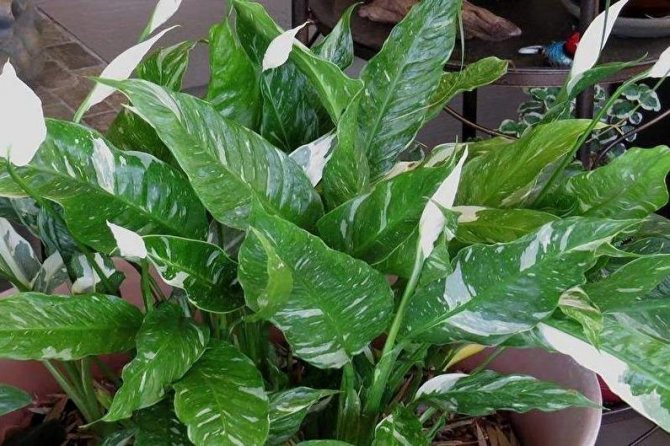

Green leaves of spathiphyllum domino
The stains are larger and are located to the sides of the middle of the leaf in the form of a herringbone. The difference between Picasso's spathiphyllum picasso and Domino's or gemini is that there are differences in the leaves. At Picasso, they are more white. There are leaves on the bush with large white stripes, and completely white.

